Music is the universal language
“Glory to God in the highest heaven, and on earth peace to those on whom his favor rests.” - Luke 2:14
Premier Guitar
A Look Inside Montreal’s Guitar-Building Cooperative
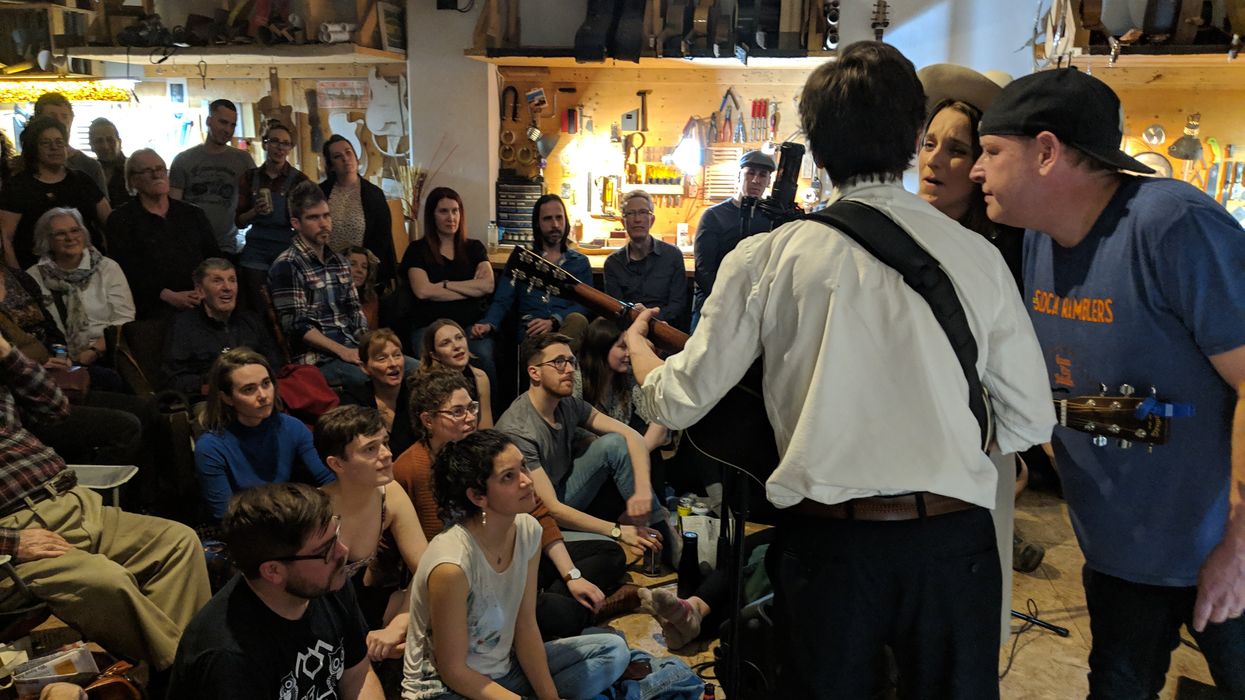
It was 2022. I had just moved across the country from Edmonton, Alberta, to Montreal, Quebec, and I was working a remote tech job that I didn’t like very much. Outside my home office, Montreal was just starting to poke its head out of the Covid lockdowns, and a small taste of its arts and music scene planted a seed in my brain. I had to find something better to do than that tech job.
I stumbled across the Mile End Guitar Coop while searching for guitar stores. But this was clearly something more interesting than just a retail shop; their website explained that this was a cooperative of independent guitar builders.
The first time that people set foot in the shop, they often stop at the door for a moment in awe. That’s exactly what I did. The first thing I noticed was that the shop smelled really good—like wood and coffee. All around were tools, stacks of wood, machines, and guitars in various stages of the building process. I was shown around by Nicholas Brygidyr of NGB Guitars, a former coop member, and Brett Hawes, a current member who runs Belvedere Instruments. Nick and Brett showed me how they wind custom pickups. I was fascinated!
On another visit, I talked to Josh Greenberg of Larkspur Lutherie. He showed me his gypsy-jazz guitars, some of the loudest, clearest acoustic guitars I’ve played. I was introduced to Nic Delisle of Island Instruments and held some of his retro-inspired electric guitars.
“One of the most valuable aspects of the Mile End Guitar Coop is the sharing of ideas.”
I also met the founders of the coop: Mike Kennedy of Michael Kennedy Guitars and Jeremy Clark of 52 Instruments. Mike and Jeremy told me how they started the coop in 2008 after apprenticing with renowned builder Sergei de Jonge; the coop was built partly to continue this long tradition of passing on experience to newcomers. While I was there, I watched Mike bend sides for a guitar. The smell of heat and steam through Indian rosewood was delicious, and something I remember to this day!
Over the course of the next several months, I learned how to build an acoustic guitar as Mike’s apprentice—an invaluable experience. Eventually, a spot opened up for me in the coop and I became a full member. Since then, I quit my tech job, and for the past couple of years, I’ve been building my own Ursa Instruments banjos and doing repairs for local musicians. I’ve got some guitar builds on the way, too!
I always dreamed of building instruments, but the barriers to entry seemed insurmountable. First, I would need to learn the craft. Then, I’d need to set up my own shop, pay rent, and buy machines and tools—all this before even thinking about where to find customers. I know I speak for all my shopmates when I say that without the support of the coop, most of us wouldn’t be able to do this.
We often get asked by other builders about the logistics of setting up a coop. We are legally designated as a cooperative, and we share many expenses, the largest being rent. But that’s just the legal side of things. One of the most valuable aspects of the Mile End Guitar Coop is the sharing of ideas. Despite the fact that we all have our own business, everyone is eager to share. Techniques are developed and spread around the shop. For instance, a method of laminating guitar sides known as “structured sides” was incubated in this shop. I believe I’m the first person to use this technique for banjo rims! I’ve also learned a lot about the testing of the acoustic properties of wood, mainly from Jeremy, who has developed a simple system of measuring the stiffness of guitar tops.
Another one of my mentors in the shop is Lenny Piroth-Robert of Daddy Mojo Instruments. Every aspect, from the wood, to the paint, to each knob, is chosen with an uncompromising eye. Lenny has also built a few electric banjos, and we’ve traded notes about banjo neck carving and setup. I’d also like to give a shoutout to my other shopmates: Morgan Deslongchamps (Deslongchamps Guitars), Oliver Duval-Quinn (Quinn Guitars), and Mathieu Dallaire-Walker (Dallaire-Walker Lutherie)—all doing world-class work.
Beyond just being a workshop, we also want the coop to facilitate music from local and travelling musicians. We host about one show each month in the shop. These shows are intimate affairs where everyone sits on the floor under lamplight and listens to an acoustic performance. We want the coop to be a community hub for musicians and builders.
The Mile End Guitar Coop is a very special place to myself, my shopmates, and the many people around the world who play our instruments. Next time you’re thinking about ordering a custom instrument, whether it be an acoustic guitar, classical guitar, banjo, or something else, consider one of us. Or, if you’re in Montreal, get in touch, and we’ll schedule a visit.
The Music Education Foundation Announces MusicPro ’26

Give A Note Foundation, a 501(c)(3) organization dedicated to nurturing, growing, and strengthening music education opportunities, announced the MusicPro’26conference for professional and aspiring musical artists to take place March 27-29, 2026, at MusiciansInstitute in Hollywood. The event will feature learning sessions about achieving success in today’s music industry and provide artists with a unique opportunity to network with fellow musicians and leaders in the music industry. Founding sponsors include MusicPro Insurance, Pandora AMP, SoundExchange,BMI, PaulReed Smith Guitars, Pearl Musical Instrument Co., DistroKid, Bandzoogle, California State University Northridge, Let Music Fill My World, Musicpreneur Academy, Music Connection, Premier Guitar, andAmerican Songwriter, among others. A waiting list for attendees was activated today and can be found at musicpro26.com, with attendee badges going on sale on October 24, 2025.
“According to Luminate, 100,000 to 120,000 new songs are uploaded to streaming services every day, making the challenge of ‘breaking out’ harder than ever,” said Give A Note CEO Dendy Jarrett.“MusicPro’26, will give artists a chance to immerse themselves in the latest trends, discuss collaborations, and contemplate new strategies."
The Musicians Institute campus during spring break is the perfect site for such an endeavor, brimming with music and AV gear and the personnel to run it. With multiple state-of-the art recording studios, wired classrooms, multiple stages and private one-on-one consulting rooms, a music college becomes an extraordinary music meeting facility.
Attendees can expect a robust schedule of panel discussions, live interviews and keynotes, workshops, demonstrations ,performances and receptions announced periodically from October through March. MusicPro ’26 is produced by Westchester Media. Companies wishing to exhibit, create content and/or sponsor should reach out to Jake Martin at jmartin@intunepartners.com.
About Give A Note Foundation:
Give A Note Foundation is a national 501(c)(3) organization with a mission to engage and empower educators, inspire students, and expand the reach and impact of music education. Founded in 2011 with an initial investment from 21st Century Fox and TV show GLEE, and in cooperation with CMA Foundation,Radio Disney, and National Association for Music Education, Give A Note has awarded grants in excess of$1.5 million dollars. Give A Note delivers opportunities for students to become their best selves through learning and creating music. #MusicEdMatters. “Creating Better Humans Through Music."
Seymour Duncan Announces The Joe Bonamassa "Bolin Burst" Humbucker Set
Owning a guitar that was played by one of your musical heroes is a rare opportunity, made even more remarkable when the instrument’s sound lives up to its legacy. Joe Bonamassa has long been a fan of the late great Tommy Bolin, whose captivating solo music and work with Deep Purple, James Gang, Billy Cobham, and Zephyr influenced generations of rock & fusion guitarists.
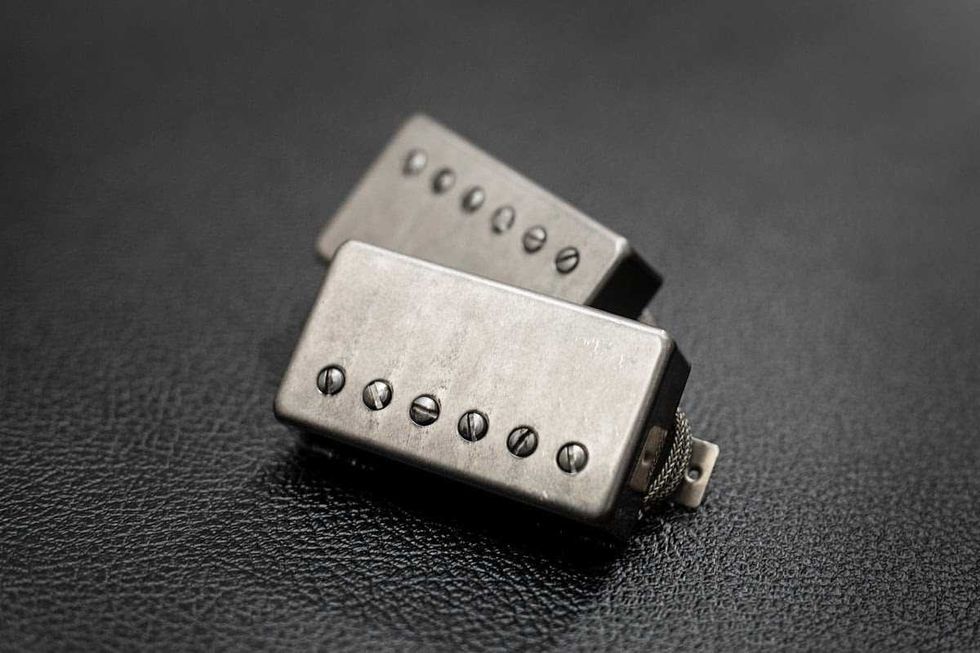
The Seymour Duncan Custom Shop is proud to offer this special pickup set featuring:
- Precisely recreated original 1960 P.A.F. humbuckers analyzed by the Seymour Duncan Custom Shop
- Limited Edition First Run (500 sets) feature signatures from Joe Bonamassa and Seymour W. Duncan
- Alnico 2 Magnets deliver authentic vintage tonality with dynamic bridge and warm neck pickup characteristics
- Custom Aging process matches original pickups' authentic vintage appearance
- A portion of the Proceeds Support Tommy Bolin's Musical Legacy through dedicated endowment and memorial funds
MAP pricing:
Set: $375.00
When Joe met Tommy’s late brother Johnnie, he inquired about a very special 1960 Gibson® Les Paul® that Tommy had played throughout his career. The “Bolin Burst” Les Paul was originally purchased and owned by Tommy’s friend and long-time guitar tech David Brown and became his replacement after his own Les Paul goldtop was stolen at a Zephyr gig. The guitar features a unique American flag pickguard hand-painted by Brown in the early 70s. It was meant to be an American twist on the British Invasion’s Union Jack which was so prevalent in artwork at the time. A Fender-style Bigsby® vibrato was also pulled off a Telecaster® and fixed on the Les Paul at Tommy’s request to better suit his playing style. These modifications aside, it is acknowledged that the fine tone of this instrument came to a great extent from its original pickups: a very special set of P.A.F. humbuckers.
After an extensive 10-year search, Joe was able to locate and purchase this one-of-a-kind guitar from David Brown himself. Admiring the unique sonic qualities of this particular guitar, Joe approached his friends at Seymour Duncan to analyze in detail the P.A.F.s in order to create his newest pickup project. The Seymour Duncan Custom Shop was able to successfully recreate the iconic tone of the “Bolin Burst” pickups and Joe and the Bolin estate are now making them available to everyone.
The Joe Bonamassa “Bolin Burst” Humbucker set utilizes Alnico 2 magnets to replicate the original’s sweet vintage tonality. The bridge pickup provides a dynamic and barky sound, while the neck pickup sings with warmth and clarity - especially through your favorite overdriven amp.
Aged in the Seymour Duncan Custom Shop to match the look of the original pickups, the first 500 sets of the “Bolin Burst” Humbuckers are built with bottom plates signed by Joe and Seymour W. Duncan and are available in limited edition numbered packaging.
A portion of the proceeds from each “Bolin Burst” Humbucker set will be donated to the Tommy Bolin Endowment and Tommy Bolin Memorial Fund.
Nuno Bettencourt Launches Own Guitar Company, Nuno Guitars
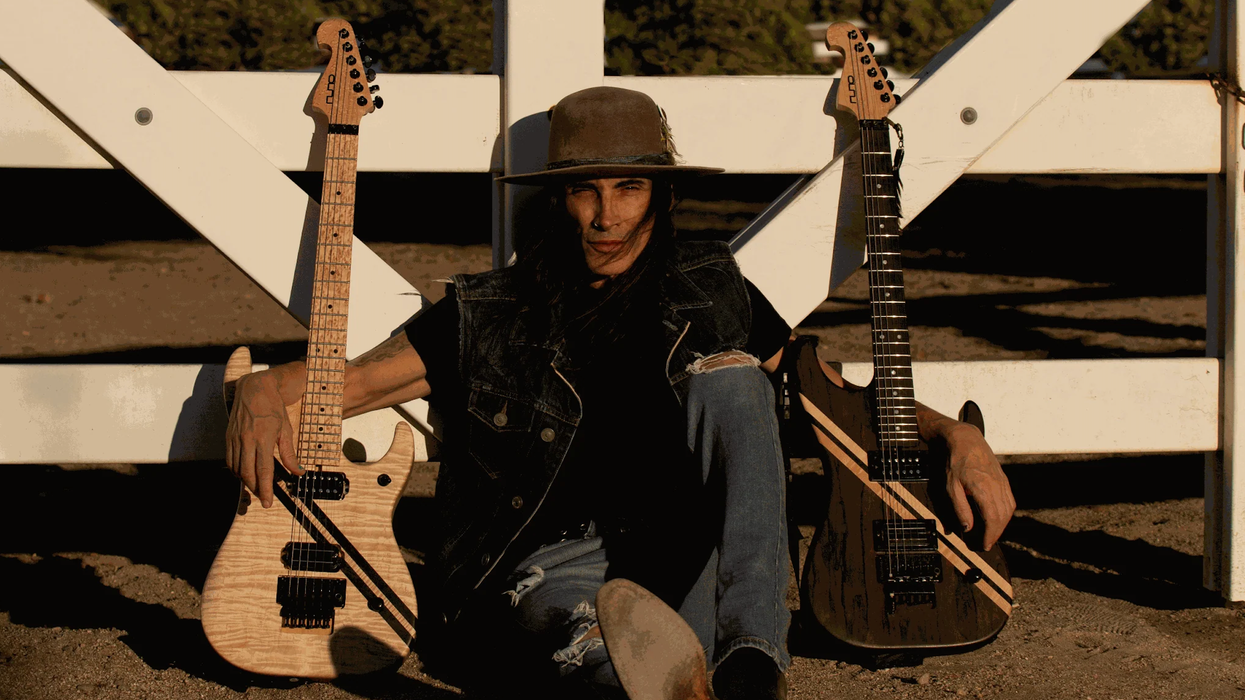
Legendary guitarist Nuno Bettencourt has announced the launch of Nuno Guitars, his own guitar company, marking a new chapter after more than 30 years with Washburn.
"I'm super excited to announce that today, this second, right now as we speak in real time, I'm launching my own guitar company," Bettencourt said in a video post to his official Instagram page. "Had a great run with Washburn, a good 35 years, I believe, which is pretty insane."
The Extreme guitarist emphasized that this move has been years in the making, driven by his desire to connect more intimately with the guitar community. "One of the main reasons is I wanted to be able to kind of deal directly with y'all, with guitar players and fans that purchase any of my guitars," he explained. "I wanted to kind of build this community now and be able to engage with you on a deeper and a closer level."
Serving as both founder and CEO, Bettencourt is launching two new models—the Dark Horse and the White Stallion. These instruments represent what he calls "true workhorses" that reflect the same dedication he brings to his performances.
In a direct-to-consumer approach, the new venture will enable players to purchase the same guitars Nuno uses on stage and in the studio. Bettencourt could recently be seen playing the guitars onstage at Black Sabbath's Back to the Beginning benefit concert at Villa Park in Birmingham and at the 2025 MTV VMAs.
"Once you own a Nuno guitar, you are forever a part of my family," Bettencourt stated.
For more information, you can visit nunoguitars.com, though Bettencourt notes the website is still developing. The company is building everything in real time, with pre-ordering options coming soon.Wolfgang Van Halen Faces the Fire
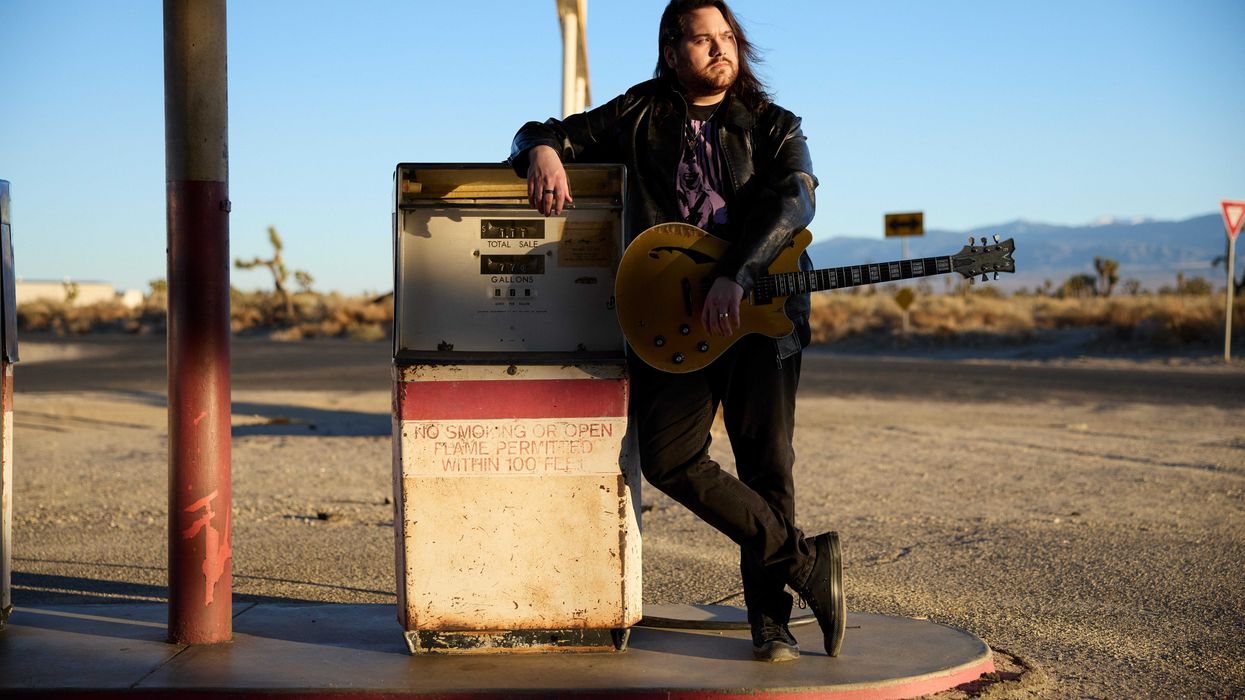
For many, Wolfgang Van Halen will always be defined by his famous origin story. The son of guitar legend Eddie Van Halen and actress Valerie Bertinelli, he first banged out rhythms on stacks of magazines before moving to real drums. As a teenager, he unexpectedly became the spark for Van Halen’s mid-2000s reunion with David Lee Roth—a run that brought long-awaited, sold-out tours, a 2012 studio album, and a 2015 live release. The band’s time, however, ended when Eddie passed away in October 2020 after a long battle with cancer. In the years between their final tour and his father’s death, Wolf had quietly been crafting a solo album, which he set aside to spend more time with Eddie.
In time, Van Halen returned to the music he’d quietly begun before his father’s passing. In late 2020, he unveiled his debut single, “The Distance,” a heartfelt tribute to Eddie that introduced his Mammoth WVH project to the world. The album that followed was very much his own—he wrote the songs, sang, and played all the instruments. From there, he quickly established himself on his own terms. Four years later, he was riding high on the strength of two acclaimed albums, with his sophomore effort, Mammoth II, building on the promise of his lauded debut. Throughout that cycle, Wolfgang did it his way—opening for Metallica, Foo Fighters, Creed, and Slash featuring Myles Kennedy and the Conspirators, while also packing venues nationwide on his first proper U.S. headlining tour.
While things couldn’t have been going any better professionally, Van Halen slowly felt the angst of this budding success catching up to him. On a September 2024 flight to Mexico to close out his stadium run with Metallica, the multi-instrumentalist felt a strange pain suddenly take over his body. Then his vision started to blur, and he felt like he was going to vomit. He turned to his uncle, Patrick Bertinelli, one of the “trusted people” who goes on tour with him, swiped at his leg, and told him he didn’t feel well in the manner of a seven-year-old who had a tummy ache. Cold and drenched in sweat, Van Halen’s uncle put his hand on his head and said, “Yeah, you don’t feel good, man.” After what felt like hours in the airplane bathroom—but was really about 25 minutes—the sensation finally passed.
What was really going on was the culmination of nerves that ended up being all-encompassing. With Mexico City’s altitude nearing 7,000 feet, and having never set foot in the city before, Van Halen was worried about how he’d be able to sing in high elevation. It was also the final show of the Metallica jaunt, so he wanted to wrap things on a positive note. Add to that a lack of sleep before the flight, and thoughts spun around in his head until he became physically sick.
Today, sitting backstage in Rhode Island ahead of another arena-opening date for Creed, the road-weary Van Halen can’t help but chuckle at that confluence of events.
“It was my first panic attack,” Van Halen says. “I never felt my body betray itself so hard. On paper, I’m a very anxious person, but that was a whole other level.”
For Van Halen, the angst of that moment proved to be a harbinger of the stresses that surrounded the making of his new third studio album.
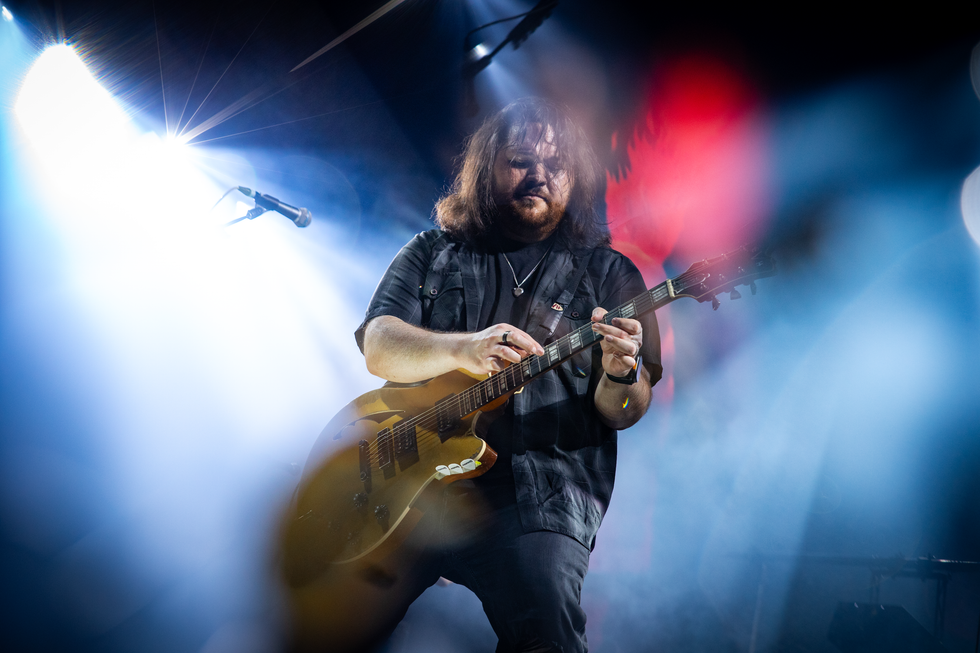
As he got to work on what was to become The End, Van Halen faced challenges beyond his control. For the better part of the past few years, the 34-year-old, along with longtime Van Halen family confidant and guitar tech Matt Bruck, painstakingly rebuilt 5150, the Los Angeles-area studio his father constructed and where every Van Halen album since 1984 had been recorded. The renovation was completed between Mammoth albums, making the recording process this time around far smoother and streamlining pre-production considerably.
While working on pre-production following the Metallica dates, Van Halen decided to make some changes, including rechristening the project Mammoth after securing the trademark to the name. Usually, Van Halen cooked up ideas on his laptop to hear them and see how they’d come together. In the rebuilt studio, fully operational to his standards, he could play a riff, run to the drums to track it, then hop over to the bass. This efficient setup allowed Van Halen, once again teaming with frequent collaborator Michael “Elvis” Baskette, to work much more smoothly. And, just like prior Mammoth albums, he played every instrument himself, calling it his “purest form of artistic expression.”
“When I was making Logic demos, the process of it bogged down the creativity,” he says. “It would take too long for me to get the drums that I wanted, so that I would give up, and the creativity would be lost.”
Now, armed with 5150 set up to his standards, the album came together quickly. Drawing from several unfinished ideas he’d carried over from previous writing sessions, Van Halen put a “fresh coat of paint” on them, setting off a creative chain reaction from which most of the ideas for The End emerged. He spent the next few months recording before heading back out on the road to play arenas with Creed.

“In comparison to how I was on the first album, which was very reserved, guitar-wise, I’m starting to worry less about what people think and what people say.”
In January, though, problems arose. Van Halen wasn’t immune to the anxiety that the wildfires destroying parts of Los Angeles caused among the city’s residents. Their proximity to 5150 was never far from his mind, looming as a menacing presence that threatened both the Van Halen home and, in turn, his studio. This tension, set against the backdrop of working on new music, underscored the lurking horrors of Mother Nature. “That’s where most of the anxious, doomsday energy in the lyrics comes from,” he says. “I couldn’t focus on my things.”
With not just his gear, but also his father’s, sitting in 5150, Van Halen knew how important it was to keep everything safe. He recalls a three-week period when Eddie’s iconic Frankenstein guitar sat in the backseat of his car, ready to go in case he had to evacuate with little time to spare.
“I thought, I’ll have Frankenstein and my wife, and we’re good,” he says. “And then we had a U-Haul filled with whatever else we felt was worth saving, which was very tough. Luckily, it didn’t come to that, but it was a traumatizing time we’re still working through.”
That tense energy from this period—the panic attack on top of the fear of losing his father’s remaining physical possessions—is reflected throughout The End. Lyrically, Mammoth songs have always been Van Halen’s outlet for processing anxiety, even when the exuberant melodies suggest otherwise. This album was no different.
Songs like the Foo Fighters-inspired “I Really Wanna” (where he addresses standing up to the bullies he’s faced over the years … and there’s a particular pointed line that sharp-eared listeners will catch) and “One of a Kind”—two of his favorites—came together smoothly thanks to the streamlined pre-production process. In fact, he says he wouldn’t have taken a chance on the “wacky” tempo changes in “One of a Kind” without it.
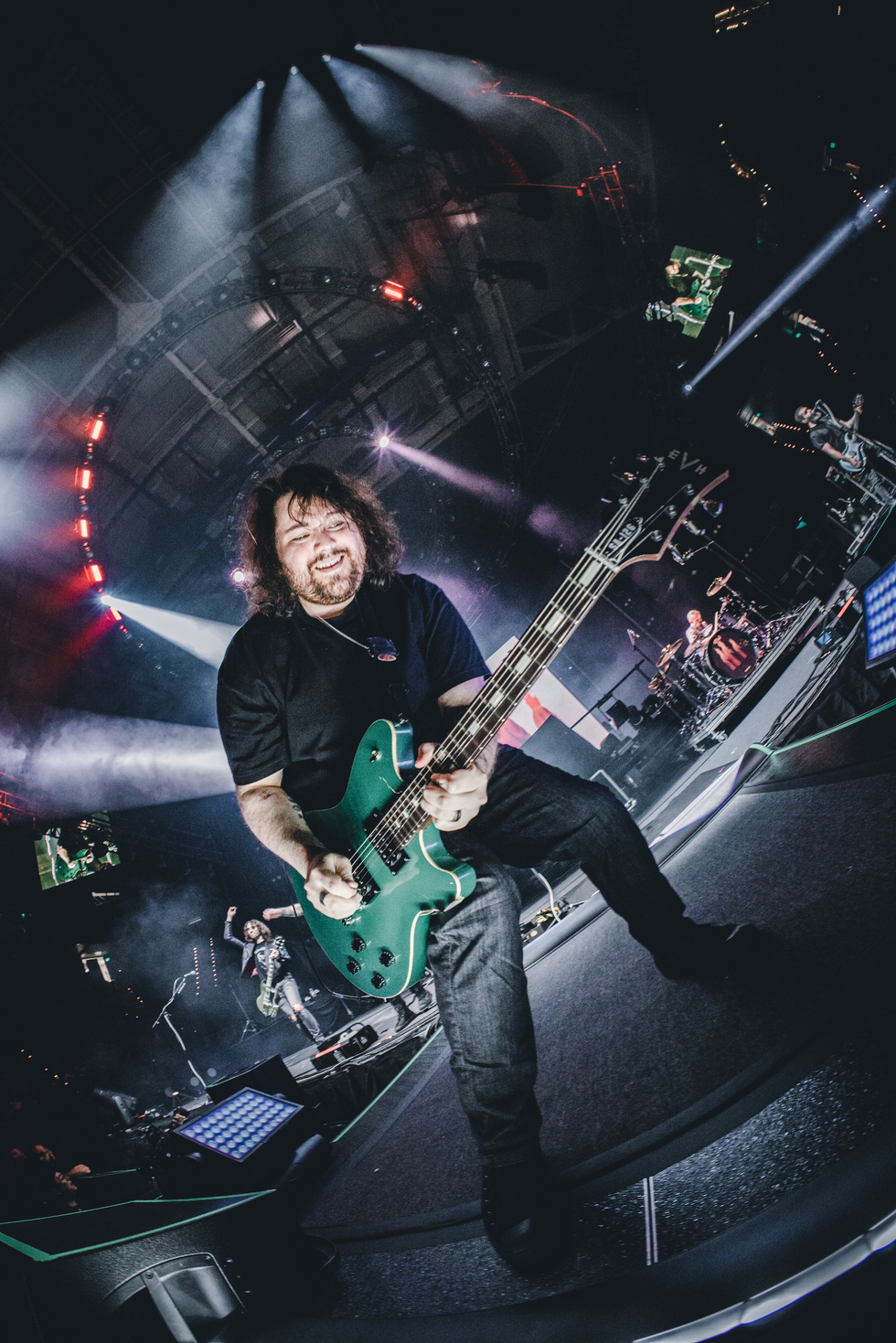
This didn’t mean the work was easy. Van Halen pushed himself as both a musician and vocalist, and laying down his vocals proved to be the toughest challenge yet. “I was uncomfortable a lot of the time,” he says of the process. But stepping out of his comfort zone—for example, on the bluesy “Better Off”—forced him to grow as a singer.
The End isn’t what its title implies. Instead, after finding his way on his first few albums, it’s a cohesive body of work that shows the depth and growth of Van Halen’s songwriting. Look no further than the title track, which opens with a tapped sequence reminiscent of you-know-who. (“It was fun to have that ear-catching moment,” he says.) It’s an idea Van Halen had been sitting for nearly a decade, just waiting for the perfect song where it would finally fit.
“I always thought it was a little over the top,” Van Halen says. “I thought of it as a challenge: ‘How can you make this the centerpiece of an idea, but still make a cohesive song around it?’ That was the songwriting challenge.”
It’s one that he aced. Throughout the song’s fun, in-your-face three-and-a-half minutes (listen closely, and there’s a nod to “Source of Infection” from OU812), Van Halen shreds with the confidence of a guitar wizard and the ease of a natural on what stands as The End’s leanest, meanest, most action-packed song. And speaking of action-packed, the accompanying video was directed by none other than legendary “Mariachi-style” filmmaker Robert Rodriguez.
A longtime fan of Rodriguez (Van Halen cites From Dusk to Dawn and Spy Kids as favorites), the two met at a show on the Mammoth II tour in the director’s hometown of Austin. The thought of Rodriguez directing a Mammoth video felt like a “pie-in-the-sky dream.” After playing demos of the new material for the filmmaker, Van Halen worked up the courage to ask Rodriguez if he’d be up for it, and he was intrigued. When Van Halen sent him the completed version of “The End,” Rodriguez came on board, bringing effects guru Greg Nicotero along with him.
“I never felt my body betray itself so hard. On paper, I’m a very anxious person, but that was a whole other level.”
“The amount of talent being utilized for such a silly thing just blew my mind,” Van Halen says of the zombie-themed video, which includes cameos from actor Danny Trejo, Slash, Myles Kennedy, and Valerie Bertinelli. “It was so fun … it was happy, with smiles throughout the whole shoot.”
At its core, The End is a balanced, guitar-driven album. Although Van Halen still considers himself a drummer—the first instrument he ever played—his guitar work has matured, and he sounds more confident than ever. There are flashes of virtuosity, as on the title track, but overall, he focuses on what best serves each composition.
“In comparison to how I was on the first album, which was very reserved, guitar-wise, I’m starting to worry less about what people think and what people say,” Van Halen explains. While The End, he says, “may be a bit reserved compared to Mammoth II, it feels more balanced this time around. It has a rawer vibe, and I was happy to keep the rough edges for people to feel like they’re in the studio with me.”
“There are a lot of expectations around me—so many preconceived ideas that it feels impossible for anyone to have a neutral opinion.”
With The End, Van Halen takes a reflective look inside. After years of having millions of fans watch him since he was barely able to drive, he’s finally comfortable with his place in music. So much so that it’s allowed him the vision to start looking further down the road. While recording The End was fruitful, four remaining song ideas weren’t fleshed out. Those could serve as the foundation to a fourth album, one that Van Halen notes that even without writing new material, he’d have plenty in the bank to draw from. By merging the old and new, he can turn a simple idea into something that feels more alive—a mantra he carries into every Mammoth session.
“There are a lot of expectations around me—so many preconceived ideas that it feels impossible for anyone to have a neutral opinion,” he says. “From the beginning, I’ve tried to stand out as my own person, without all of the bullshit that comes with the name and the controversies and everything that's come before me. It's just nice to be able to be judged for the music itself, rather than what people think or say about me.”
When reminded that some of his peers—musicians he admired as a young player—are now among rock’s biggest names, Van Halen quickly retorts that most people still see him as a kid. Some, he jokes, will never see him as anything more than that.
“That’s the tough thing!” he says with a laugh. “I feel like I'm gonna be a kid until I’m an old man. I’m never going to be just a guy. Like, I just want to be a guy.”Wolfgang Van Halen’s Gear
Guitars and Basses
EVH SA-126 goldtop (SA-126 Tim Shaw pickups)
EVH SA-126 Pink finish (SA-126 Tim Shaw pickups)
Prototype Wolfgang 4-string
Amp
EVH 5150III 50 Watt (6L6) (“NOEL”) w/ EVH 5150III 4x12 cabinet
Effects
Dunlop MXR EVH Phase 90
Dunlop MXR EVH Flanger
Dunlop Cry Baby EVH wah
Dunlop MXR Micro Flanger
Dunlop MXR Micro Chorus
Dunlop MXR Sub Machine
Dunlop MXR Uni-VibeDunlop MXR Uni-Vibe
ZVEX Woolly Mammoth Vexter
Electro-Harmonix Micro Synthesizer (vintage)
Electro-Harmonix Small Clone
EarthQuaker Devices Hoof Reaper
Ceriatone Centura
DigiTech DOD Envelope Filter 440
Boss RE-202 Space Echo
Boss OC-3 Super Octave
Boss RV-6 Reverb
Boss CE-5 Chorus Ensemble
Guild Brian May boost
Strings, Picks, and Accessories
Dunlop Max-Grip .60mm
EVH .010–.049
EVH cables
Crazy Tube Circuits Announces Mirage JR
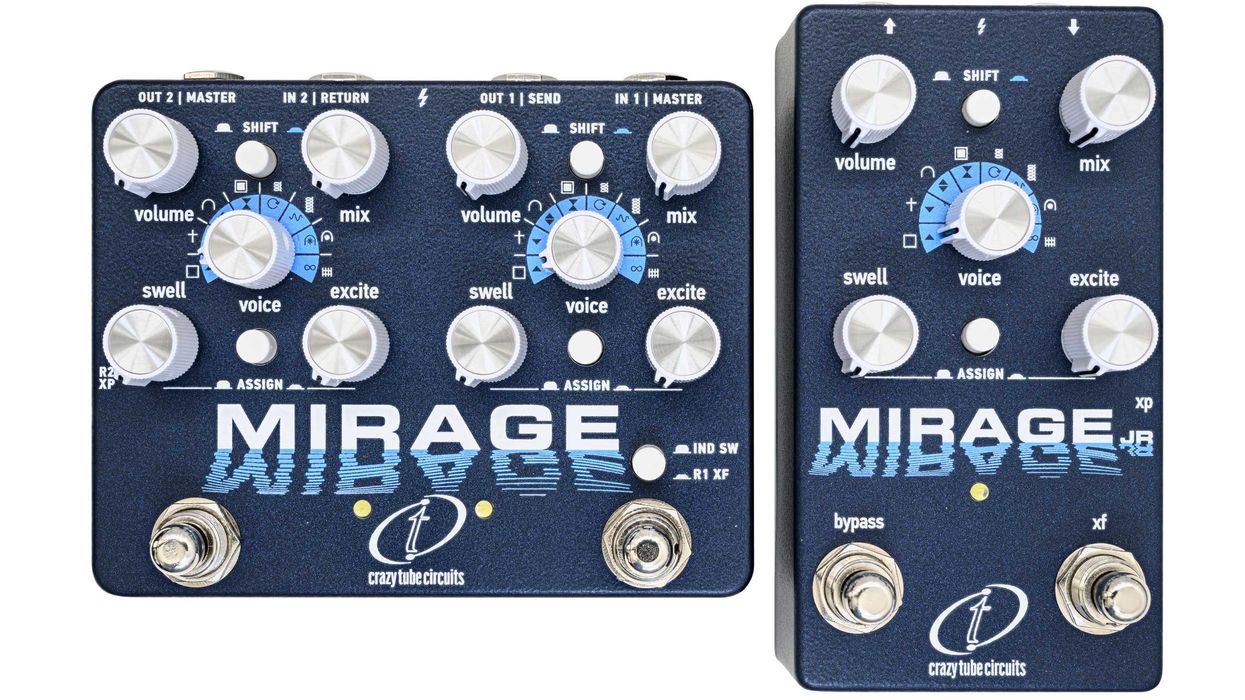
Crazy Tube Circuits are proud to introduce the Mirage JR, a streamlined version of the Mirage dual-engine reverb.
Engineered with the same studio-grade processing power as its big brother, Mirage JR delivers the lush, detailed soundscapes in a more compact, pedalboard-friendly design. Featuring a curated selection of 16 immersive reverb algorithms that cover everything from authentic room and spring emulations to expansive ambient textures.
Mirage JR is a compact reverb powerhouse that delivers all the creative range of its big sibling in a streamlined, single-engine mono format. It offers the same studio grade processing, intuitive layout, and algorithm selection.
Built for guitarists, bassists, synth players, and ambient creators who want maximum sound without complexity. Whether you’re chasing vintage plate tones, cinematic shimmer, or frozen walls of reverb, Mirage JR brings it all together in one expressive unit.
The reverb engine runs any of 16 carefully crafted reverb algorithms, organized into two banks of natural, familiar spaces or modern and experimental territories. Four dedicated knobs and two expression controls enable powerful real time interactions, from expressive shimmer bursts and freeze triggers to evolving modulated textures.
Despite its compact footprint, Mirage JR gives you plenty to show off, visually, sonically, and practically. It shines as a mono front end spatial effect, but it’s equally at home in pedal switchers, synth setups, or even as a send effect in the studio, bringing the magic of the original Mirage to any rig.
Street price $249
For more information visit www.crazytubecircuits.com/mirage-jr
Spector Introduces the NS Icon Bolt-On Series
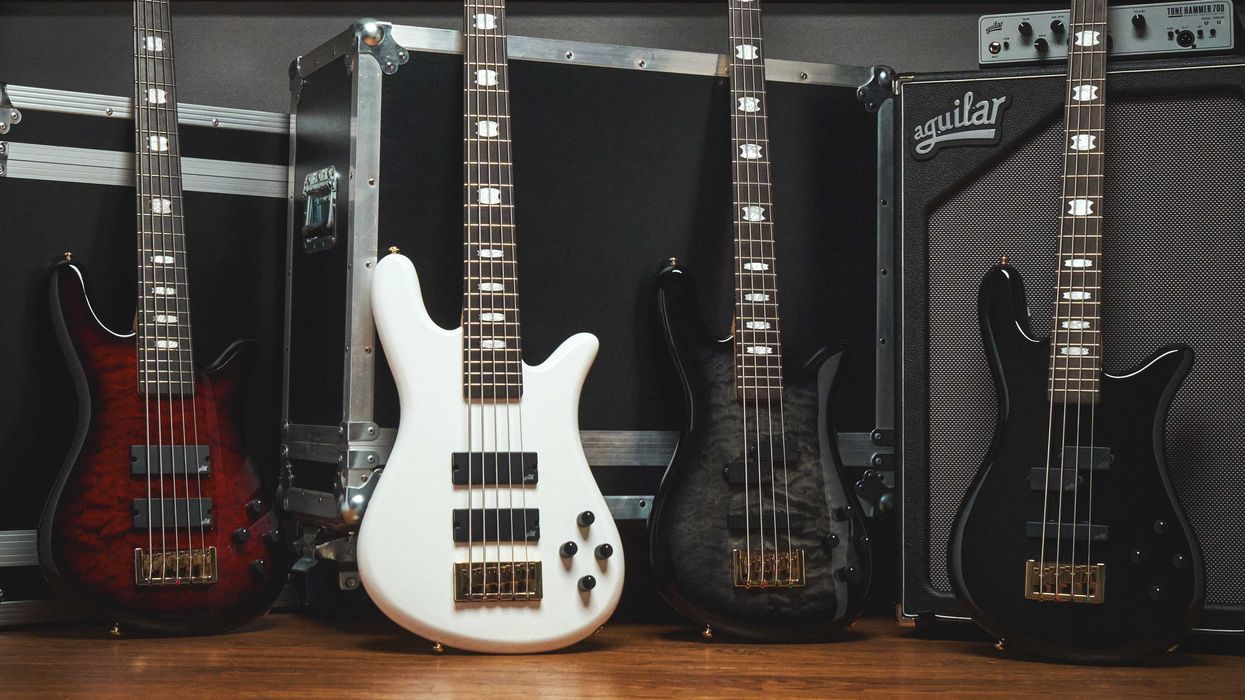
For nearly five decades, Spector has been synonymous with innovation, craftsmanship, and the unmistakable tone that has shaped the sound of modern bass. Today, Spector unveils the next evolution in the storied lineage: the NS Icon Bolt-On series.
The NS Icon Bolt-On brings the revered NS design into a bold new era. Designed by the expert luthiers at the Spector Custom Shop in Woodstock, NY, this new series captures the essence of the flagship instruments while offering a fresh take for today’s player. With its fully carved body, premium tonewoods, and professional-grade hardware, the NS Icon Bolt-On delivers the iconic Spector feel and tone in a bolt-on format.

Each NS Icon Bolt-On features a resonant Alder body paired with a bolt-on 3-piece rock maple neck and a smooth rosewood fingerboard—tonewoods that have defined Spector’s sonic signature for generations. The body’s fully curved contour ensures unmatched comfort and playability, while the neck profile, nut width, and fingerboard radius are meticulously crafted to meet the standards of our Custom Shop.
“The NS Icon Bolt-On brings the essence of Spector to more players than ever before. We took everything players have loved about USA built NS basses for nearly 50 years and combined them with a classic Bolt-On construction to achieve a playing experience that is both immediately recognizable and unique at the same time. The introduction of the NS Icon Bolt-On is the next step on our journey of bringing the best that Spector has to offer to bass players at every level.” - Wil DeYoung – Spector Custom Shop Manager
Available in both 4-string and 5-string configurations, players can choose from two solid gloss finishes: Black and White, or two stunning stain finishes: Black Cherry and Black Stain, each adorned with a highly figured quilted maple top. Gold hardware, signature Crown inlays, a polished brass nut, and a fully intonating locking bridge complete the look.
At the heart of the NS Icon Bolt-On is a custom-voiced electronics package developed in collaboration with Aguilar. The 4-string model features a Reverse P and J pickup configuration, while the 5-string boasts dual Soapbar pickups. Paired with the Aguilar OBP-2 preamp, these pickups deliver the deep, articulate lows and crystal-clear highs that define the Spector sound—now with even greater versatility.
To learn more about the NS Icon Bolt-On please visit www.spectorbass.com
Street Price: $1199.99 USD NS-4 Icon
$1299.99 USD NS-5 Icon
Levy’s New Night Life, Clairvoyant, and Holiday Strap Series

Levy’s Music has introduced two new guitar strap series designed to capture attention in the dark and tap into the mystic. The Clairvoyant Series and Night Life Series blend visual storytelling with performance-ready functionality, expanding the Levy’s collection with bold new designs for expressive players.
The Night Life Series features black leather straps embroidered with spider webs, lightning bolts, and moon-and-star motifs that glow in the dark after charging under light. Built from soft garment leather and sized for comfort during long sets, the straps are designed to deliver a showstopping look without compromising durability.

The Clairvoyant Series explores supernatural symbolism through printed poly straps inspired by tarot cards, Ouija boards, and the protective gaze of the evil eye. Each design brings an otherworldly aesthetic to the stage while offering practical features like genuine leather ends and adjustable length for versatile use. Both series are handcrafted in Nova Scotia and available now through authorized Levy’s dealers and distributors.

Levy’s is expanding its holiday-themed Christmas Strap Series with two new designs: the Plaid Christmas Strap and the Ugly Christmas Sweater Strap. Both styles join the existing seasonal lineup and bring fresh holiday personality to Levy’s’ growing collection of print straps.
Handcrafted in Nova Scotia, Canada, each strap delivers the comfort and quality Levy’s is known for while embracing playful, festive visuals. The Plaid Christmas Strap features a classic red and green tartan pattern, while the Ugly Christmas Sweater Strap leans into bold, sweater-inspired graphics that celebrate the lighter side of the season.
Both straps are constructed with standard series materials, including a polyester body and genuine leather ends, and adjust from 35.25 to 60.5 inches to suit a variety of playing styles and instruments. To learn more about Levy’s guitar straps and music accessories, visit www.levysleathers.com.
Sowing in the Storm with "Ecstatic Black Metal" Band Agriculture
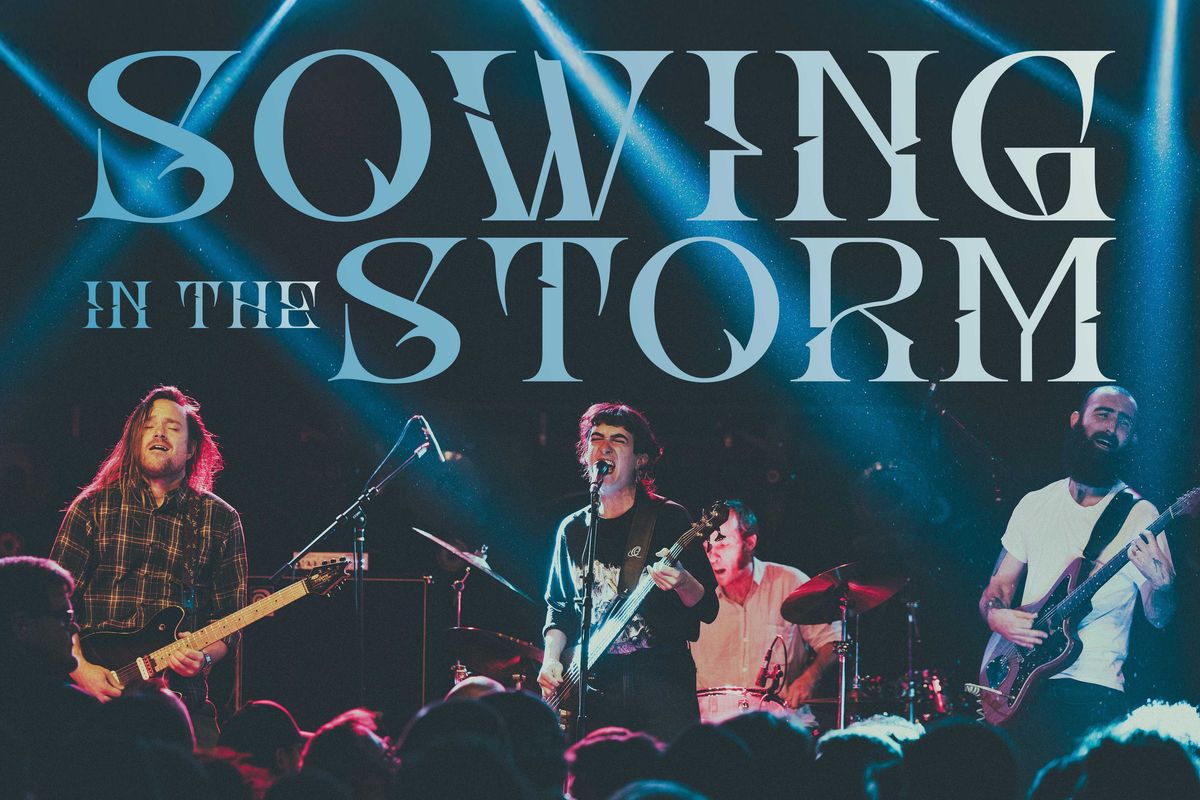
Los Angeles experimental metal band Agriculture’s new record, The Spiritual Sound, might not make sense to you at first listen. When the band sent the album to their friends, many of them were overwhelmed, if not weirded out. The band members weren’t surprised. “If I heard this record for the first time, I’d be pretty confused by it,” says guitarist and vocalist Dan Meyer.
The record opens with clanking bass strokes before a dizzying hornet’s nest of guitars and drums careens around maniacally for 20 seconds. After that, a brutal downtuned riff kicks in, accompanied by face-melting shredding. By the time the song hits the one-minute mark, and vocalist/bassist Leah B. Levinson’s dungeon-creature scream rips across the track, there have been three distinct movements. There are four more minutes, and a few more movements, to go—including a beautiful melodic reprieve that’s reprised near the song’s final moments.
It’s a thrilling shot across the bow from one of heavy music’s most fearless acts. By the end of The Spiritual Sound, Agriculture have extended their tongue-in-cheek genre designation of “ecstatic black metal” into regions like powerviolence, noise, alternative, shoegaze, and sounds that touch on folk and traditional. “Dan’s Love Song,” for example, with its nostalgic melody and simple chord progressions, could be a noise-rock interpretation of some obscure 1800s ballad. (The band lists Metallica, Slipknot, the Jesus and Mary Chain, and Bob Dylan as primary influences on the new album.) “Bodhidharma,” meanwhile, flips on its heel between headbanging metal and passages of silence, punctuated by screams, whispers, and Haug’s frozen, hulking snare and kick bursts. It also features some of Chowenhill’s most mindboggling lead guitar passages.
“The problem that I was trying to solve with my songwriting on this record was, ‘How do I write about things as they occur in my life without overly dramatizing them?’” —Leah B. Levinson
Formed in the early days of the pandemic, Agriculture—Levinson, Meyer, guitarist Richard Chowenhill, and drummer Kern Haug—have defined their sound as something that is once experimental, abrasive, and jubilant. The record title and the band’s self-determined genre designation hail from a jokey remark lobbed at them: “I love the spiritual sound of this ecstatic black metal.” The phrase, and the band, are the subject of debate on various heavy-music forums. There is a certain sense of Ursula K. Le Guin’s world-building at play in Agriculture’s music—a playfulness, curiosity, and seeming inhabitance of an alternate reality.
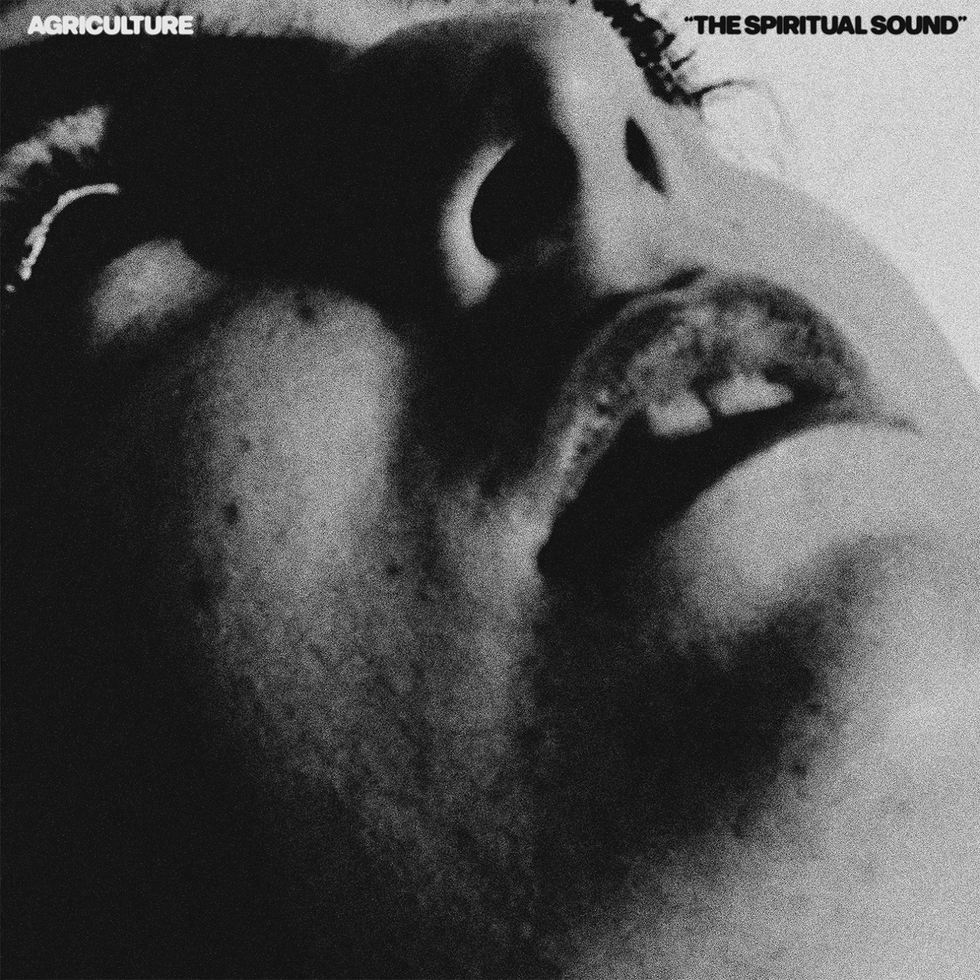
The band’s writing process for The Spiritual Sound was “unusually collaborative,” says Meyer. Songs were brought in fully formed, then torn apart and reconstituted, often with different parts. Meyer likens it to building a character at the outset of a role-playing game. “The head of this song ends up going with the body of that song,” he quips.
Once songs were solidified, they were taken to what the band calls “Richard’s kingdom”—the affectionate term for Chowenhill’s studio, where deep production began after principle tracking. That’s where vocals, overdubs, and “ear candy” were added. It’s also where plenty of sparring took place. “It is a more adventurous record,” says Levinson. “We make a lot of capital-C choices on it, and it really did require us setting aside creative differences, or at least sitting with things and being like, ‘I don’t know where this is going, I don’t like this, but I’m gonna sit with it and trust that each other has a vision.”
Chowenhill, who is trained as a composer in the classical tradition, is responsible for most of the jaw-dropping guitar theatrics on the record, influenced by shredders like Alexi Laiho and Eddie Van Halen alongside Hungarian composer György Ligeti—in particular Ligeti’s “String Quartet No. 2.” “There’s no guitars, but you can transpose those things to guitar,” he explains, naming the composition’s chromatic motion and left-hand techniques as things he considered while composing leads. His tremolo picking, in particular, is astonishing. That comes from worship of heroes like Van Halen, but also mandolin players like David Grisman and Chris Thile.
“We’re in this weird era right now where it’s actually more rare to not be hearing musical sound than it is to be hearing it.”—Dan Meyer
While Meyer drew Zen Buddhism concepts into the record on songs he composed, Levinson took inspiration from literature produced during and after the AIDS epidemic in the U.S., especially David Wojnarowicz’s Close to the Knives: A Memoir of Disintegration, a collection of essays reflecting on the crisis. Poet Ted Berrigan’s classic The Sonnets was also in view. They spurred Levinson’s lyricism toward “looking at suffering and spirituality in a quotidian sense”—an interesting exercise on a record of volatile music.
Leah B. Levinson’s Gear
Basses
Ibanez SR505E 5-string
Ernie Ball Music Man Sabre
Amps
Ampeg SVT-4 Pro head
Peavey 2x15 cab
Effects
Ibanez Pentatone Gate
One Control Mosquito Blender
One Control Black Loop with BJF Buffer
MXR M306 Poly Blue Octave
Electro-Harmonix Green Russian Big Muff
Catalinbread Carbide
Electro-Harmonix Canyon
Old Blood Noise Endeavors Haunt
Darkglass Microtubes B7K V2
Strings & Picks
Ernie Ball Regular Slinky Bass 5 strings
Dunlop Tortex Flow 1.5 mm picks
Dan Meyer’s Gear
Guitars
Custom Jazzmaster copy
Amps
Peavey 6505+ (studio)
Fender Blues Junior (studio)
Orange Pedal Baby 100 (live)
Randall Diavolo 4x12 cab
Effects
Line 6 Helix LT
Strings & Picks
Ernie Ball Skinny Top Heavy Bottom strings
Dunlop Max-Grip Jazz III picks
Richard Chowenhill’s Gear
Guitars
EVH Wolfgang HT
Amps
Peavey 6505+ (studio)
Fender Blues Junior (studio)
Orange Pedal Baby 100 (live)
Randall Diavolo 4x12 cab
Effects
Morley Steve Vai Mini Bad Horsie
Line 6 HX Stomp
JHS Muffuletta
Strings & Picks
Ernie Ball Regular Slinky strings
Dunlop Primetone Triangle Grip 1.4 mm picks

“I think when you’re working in extreme music, so much of the impulse is, ‘I have to talk about something extreme and I have to be dramatic, I’m gonna be screaming these words, they need to be about intense and immediate suffering and violent images,’” says Levinson. “The problem that I was trying to solve with my songwriting on this record was, ‘How do I write about things as they occur in my life and in my world without overly dramatizing them or without making them too much of a spectacle? Not presenting spectacles of suffering, but just how things exist in the everyday.”
“We pose this record as a rejection of ‘the vibe,’ but on the other side of that, it’s an invitation. It’s an invitation to listen, to just sit and be with us for a while.”—Richard Chowenhill
The ordinary, unremarkable facets of life, more than anything, are at the heart of Agriculture’s approach to making music—especially when it comes to the consumption of art. “We’re in this weird era right now where it’s actually more rare to not be hearing musical sound than it is to be hearing it, right?” says Dan Meyer. “We hear it everywhere, at every restaurant, in the grocery store, in the car. I think Spotify is bad. I think that flattening music into something that people just think of as sonic perfume is negative for music as a practice, both artistically and spiritually, and for us as listeners.”
“When we were writing these songs,” continues Levinson, “it’s not like we were thinking, ‘We’re gonna make some anti-vibe music.’ I don’t think that would sustain the compositional practice. A lot of these songs were really written with a mind towards live performance. I think people are pretty engaged when they’re watching us and it’s sort of a what-are-they-gonna-do-next-type thing.” Levinson says Agriculture’s work isn’t exactly “body-moving music” in the way that more groove-oriented metal is. “That’s not the show we’re selling. It’s like, stand there and look at it and be confused for a bit, and be interested and be excited, and go through some emotional experience.”
Meyer parallels the experience with the way that kōans, the reflective prompts of Zen Buddhism, demand attention. “I think that’s kind of what we’re going for,” says Meyer. “It’s like we’re waving our hands a little bit, like, ‘pay attention.’”
Chowenhill’s classical bonafides certainly contribute to the cinematic scope of Agriculture’s music. It also lends the sort of compositional depth that rewards repeat listens. “We pose this record as a rejection of ‘the vibe,’ but on the other side of that, it’s an invitation,” he says. “It’s an invitation to listen, to just sit and be with us for a while, as long as you’re willing to be here.”
Jimmy Herring: ARU, Panic, and Beyond | 100 Guitarists Podcast
This week, hosts Nick Millevoi and the shamelessly biased Jason Shadrick dive deep—much, much deeper than Nick ever imagined he would go—into the vast discography of the great Jimmy Herring. They enlist Rob Compa, formerly of Dopapod and now of Neighbor, whose greatest qualification is living in Burlington, Vermont, "the hub of all things jam bands".
Maybe you’ve heard Jimmy Herring is amazing, but the sheer "jam-ness" of his output is intimidating. We systematically go through Herring’s entire discography and in the process ruin Nick’s Apple Music algorithm. But common ground was found in Frogwings' Croakin’ at Toads, which found a new fan in Nick even though he’s slightly John Popper-phobic. Rob chimes in on his favorite nuggets from the catalog and discusses what exactly makes Herring gain such a fanbase among guitar nerds. Is it Jazz Is Dead, Phil Lesh, the ferocious McLaughlin collaboration? Plus, we decide that Herring’s “Scapegoat Blues” might be an all-time jam-band standard and required repertoire for any aspiring guitarist.
Thanks to our Sponsor Rocky Mountain Slides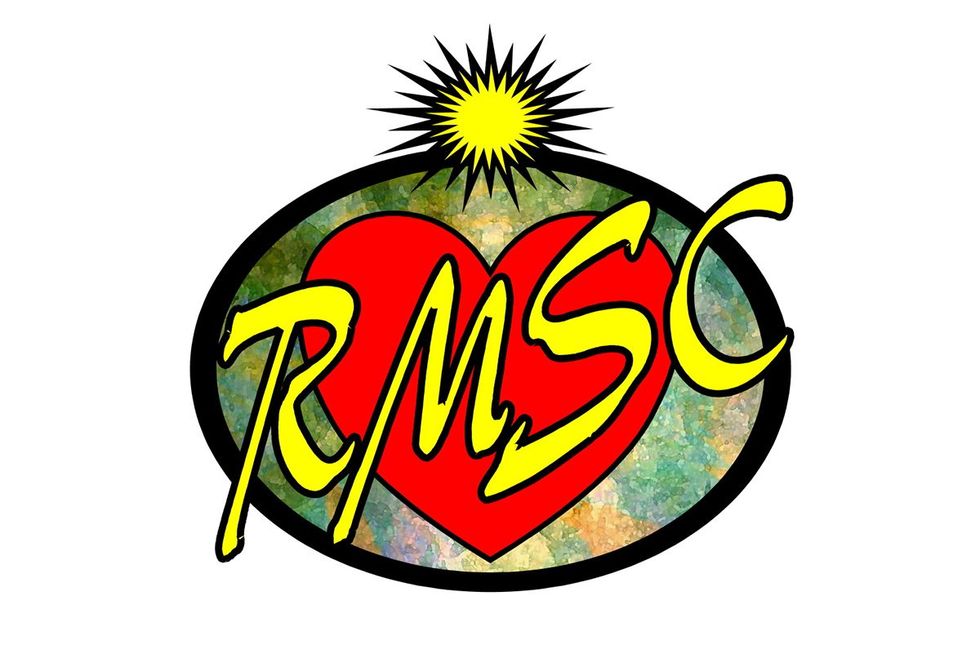
Learn More! rockymountainslides.com
Ashdown Launches UK-Built Cabinets and Amps
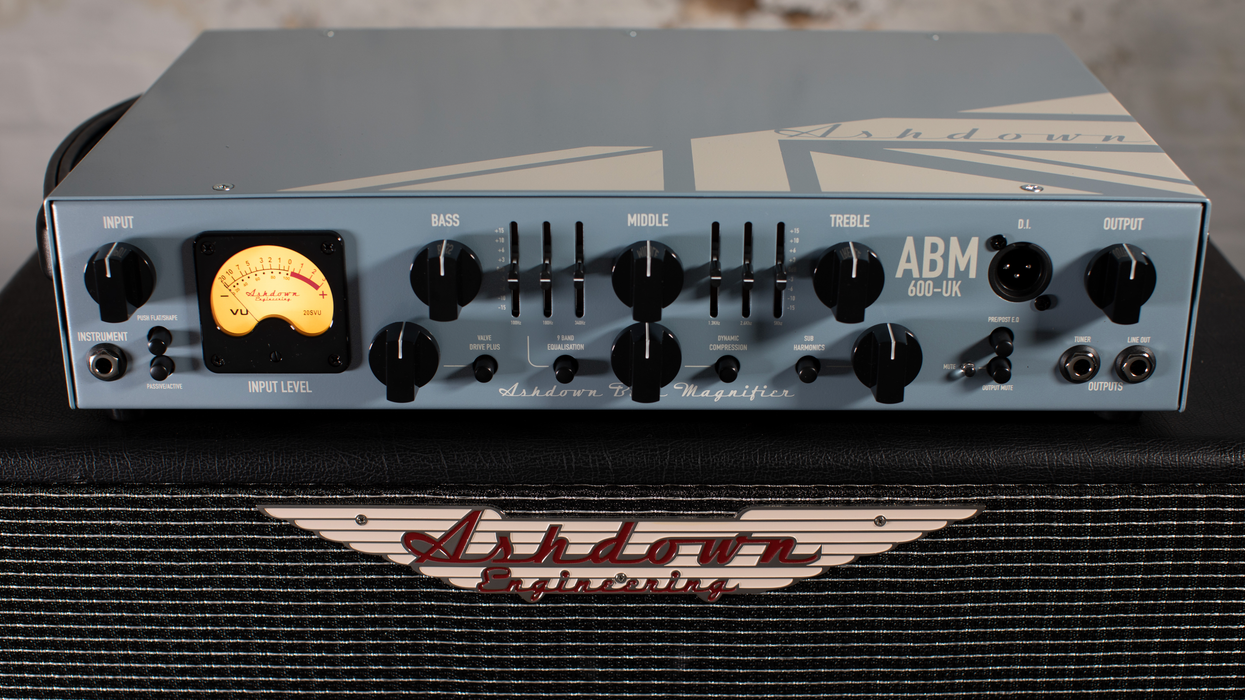
Ashdown Engineering has launched new amp and cabinet models to its flagship ABM range, now available in fully UK-built editions.
For over 25 years, the Ashdown ABM series has earned its place on some of the world’s biggest stage, trusted by professional bass players for its signature tone, flexibility, and reliability.
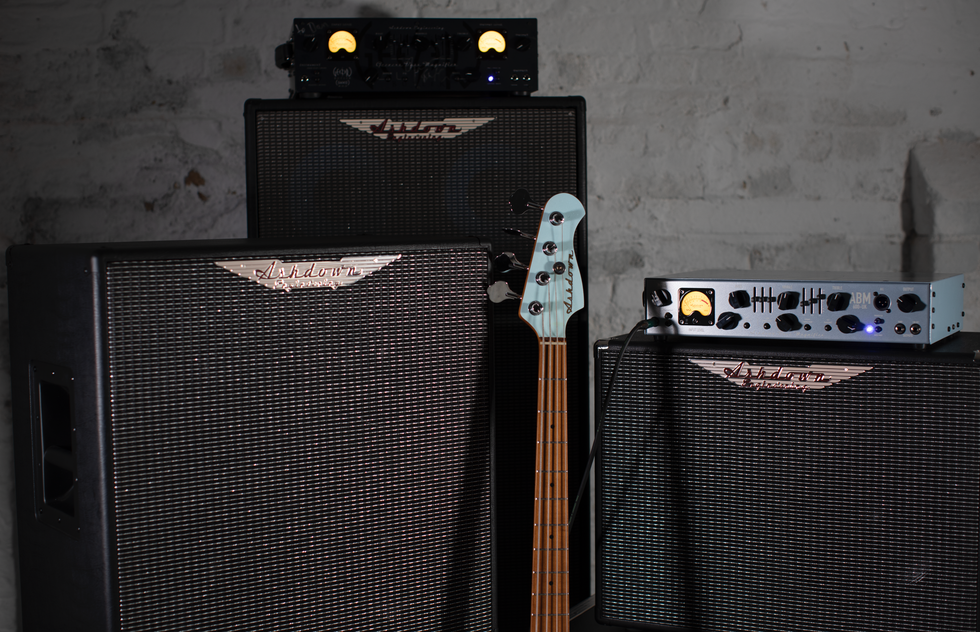
The new amps include the UK-ABM-300-EVO IV and UK-ABM-600-EVO IV. The cabinets include five newly re-engineered cabinets blending iconic ABM tone with state-of-the-art materials and superior construction, crafted entirely in the UK. The five models include the UK-ABM-810H-EVO IV, UK-ABM-410H-EVO IV, UK-ABM-210H-EVO IV, UK-ABM-115H-EVO IV and UK-ABM-112H-EVO IV.
Here are details on the two new amps. Delivering 300 watts of pure bass power, the UK-ABM-300-EVO IV combines heritage tone with modern control. Its class-leading preamp features the Variable Valve Drive Plus, giving players access to a broad tonal spectrum, from warm cleans to gritty overdrive, all foot-switchable for performance versatility. A brand-new 9-band EQ offers pinpoint tonal shaping, while the One Knob Compressor and Sub-Harmonic Generator ensure your bass remains rich, tight, and stage-ready. Professional connectivity, including FX loop, Line Input, and tuner out, make it a complete solution for live and studio applications.
For players demanding more headroom and authority, the Uk-ABM-600-EVO IV offers 600 watts of commanding power while retaining the full feature set of its 300W sibling. The enhanced 9-band EQ, signature VU meter, and foot-switchable controls for Valve Drive, Compression, EQ, and Sub-Harmonics allow seamless integration into any performance setup. Built for the modern bassist yet faithful to its roots, the UK-ABM-600-EVO IV represents the pinnacle of Ashdown’s amplifier design.
Amp specifications are as follows:
UK-ABM-300-EVO IV –
- Power Output - 300 Watt
- Speaker Outputs - 2 x Neutrick Jack/Speakon outputs
- Includes DI output, effects send and return
- Impedance - Minimum 4 Ohms
- Pre Amp Tubes - 1 x 12AX7
- H x W x D (mm) - 146 x 488 x 336
- Weight (kg) - 12.5
UK-ABM-600-EVO IV –
- Power Output - 600 Watts
- Speaker Outputs - 2 x Jack/Speakon outputs
- Includes DI output, effects send and return
- H x W x D (mm) - 146 x 489 x 336
- Weight (kg) - 12.5
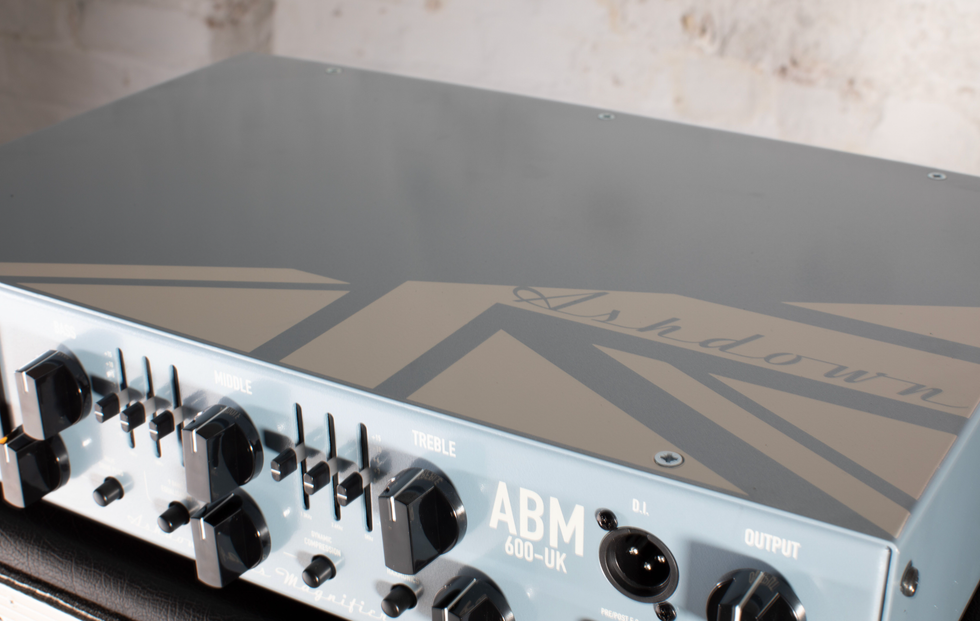
Here are details on the new line of cabinets.
- UK-ABM-810H- EVO IV, a powerhouse cabinet designed for commanding the largest of stages. Loaded with eight precision 10” ceramic drivers arranged in sealed chamber pairs, the UK-ABM-810H-EVO IV offers unmatched punch and midrange articulation. With a massive 2000W AES power handling and a switchable high-frequency horn, this is a cabinet built to deliver, night after night.
- UK-ABM-410H-EVO IV – A studio and stage staple worldwide, delivering tight response and 1000W AES of focused clarity from four 10” ceramic drivers.
- UK-ABM-210H-EVO IV – Half the size, all the tone. Ideal for smaller gigs or pairing with additional cabs, offering 500W AES.
- UK-ABM-115H-EVO IV – A 500W AES 15” cabinet for players who crave classic warmth and depth.
- UK-ABM-112H-EVO IV – Compact yet mighty, the new 300W AES 12” format is meticulously balanced and is already being heralded as the go-to cab for the range.
All cabinets feature genuine Neutrik Speakon connectors, are rear-ported for enhanced low-end performance, and are constructed from FSC-certified Mahogany plywood (or Latvian Baltic birch for the UK-ABM-810H-EVO IV) for unrivalled resonance and durability.
Cabinet specifications are as follows.
UK-ABM-112H-EVO IV
- AES Power – 300W
- Drivers – 1x12”
- Sensitivity – 98dB
- Impedance – 8 Ohms
- Magnet – Ceramic
- Dimensions (W x H x D) – 603 x 452 x 340 mm
UK-ABM-115H-EVO IV
- AES Power – 500W
- Drivers – 1x15”
- Sensitivity – 98dB
- Impedance – 8 Ohms
- Magnet – Ceramic
- Dimensions (W x H x D) - 603 x 452 x 340 mm
UK-ABM-210H-EVO IV
- AES Power – 500W
- Drivers – 2x10”
- Sensitivity – 99dB
- Impedance – 8 Ohms
- Magnet – Ceramic
- Dimensions (W x H x D) - 603 x 452 x 340 mm
UK-ABM-410H-EVO IV
- AES Power – 1000W
- Drivers – 4x10”
- Sensitivity – 102dB
- Impedance – 8 Ohms
- Magnet – Ceramic
- Dimensions (W x H x D) - 603 x 603 x 340 mm
UK-ABM-810H-EVO IV
- AES Power – 2000W
- Drivers – 8x10”
- Sensitivity – 105dB
- Impedance – 4 Ohms
- Magnet – Ceramic
- Dimensions (W x H x D) - 609 x 1150 x 415 mm
Hand-assembled at Ashdown’s UK headquarters in Essex, these amps and cabinets represent a renewed dedication to in-house engineering and local manufacturing. Every UK-ABM-EVO IV head is crafted with the same passion and precision that has defined Ashdown for decades.
For more information, visit: www.ashdownmusic.co.uk
Gear Finds: Pickups and Guitar Upgrades
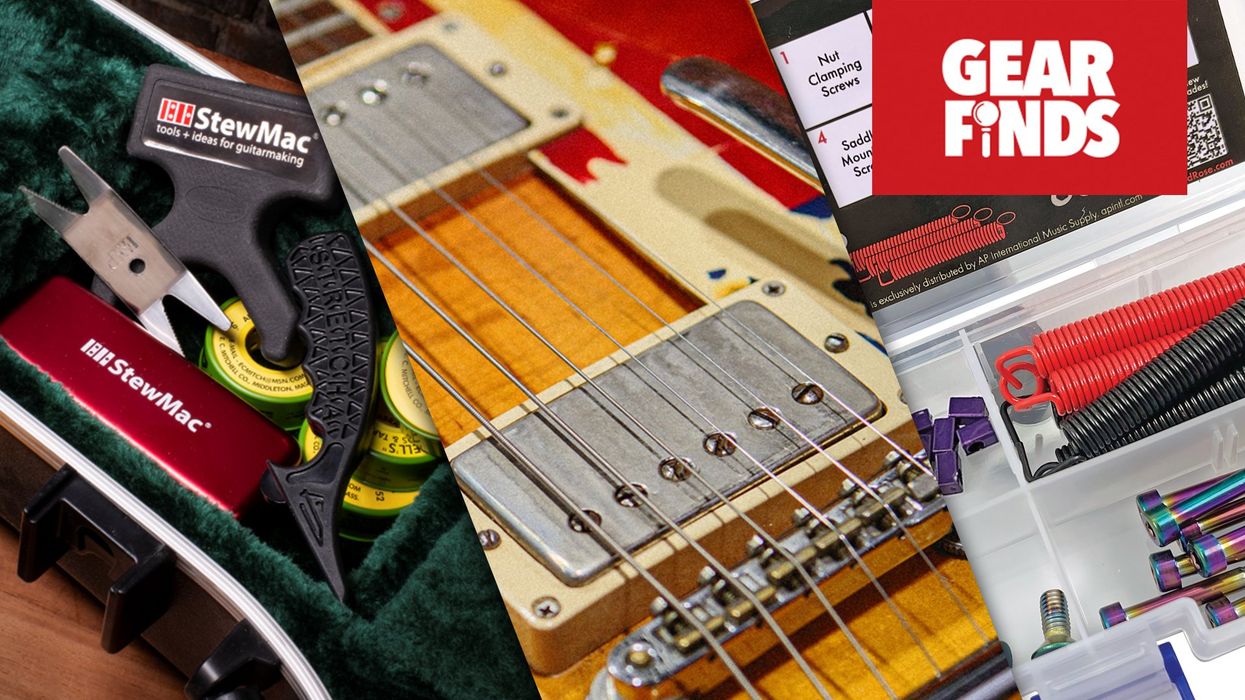
Unlock your guitar's true potential with the Fralin Pickups Push-Pull Blender Pot! Blend tones, split coils, and explore endless sonic possibilities without permanent changes. Ready to elevate your sound? Check out the Joe Bonamassa Humbucker Set and more gear to keep your music alive!
Fralin Pickups
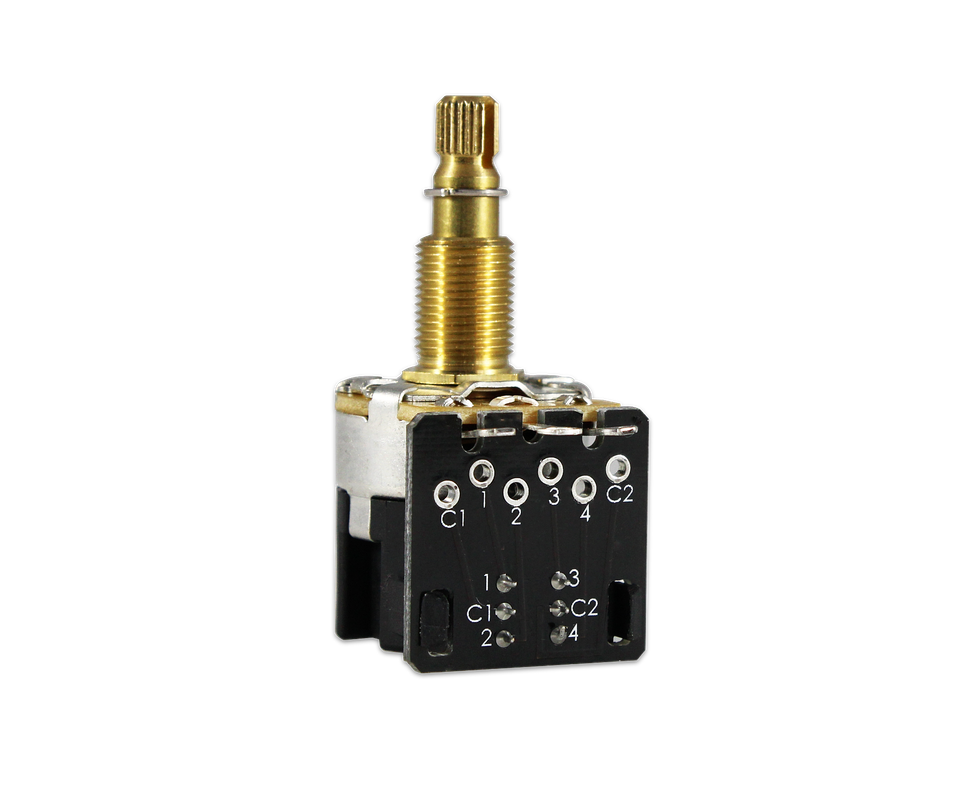
Push Pull Blender Pot
Unlock a wider range of tones with the Fralin Pickups Push-Pull Blender Pot. Compatible with guitars and basses, this versatile control blends pickup outputs, adds coil-splitting and out-of-phase options, and enables many wiring mods—giving you flexible, player-friendly tonal shaping without permanent changes to your instrument.
$25 street
Graph Tech
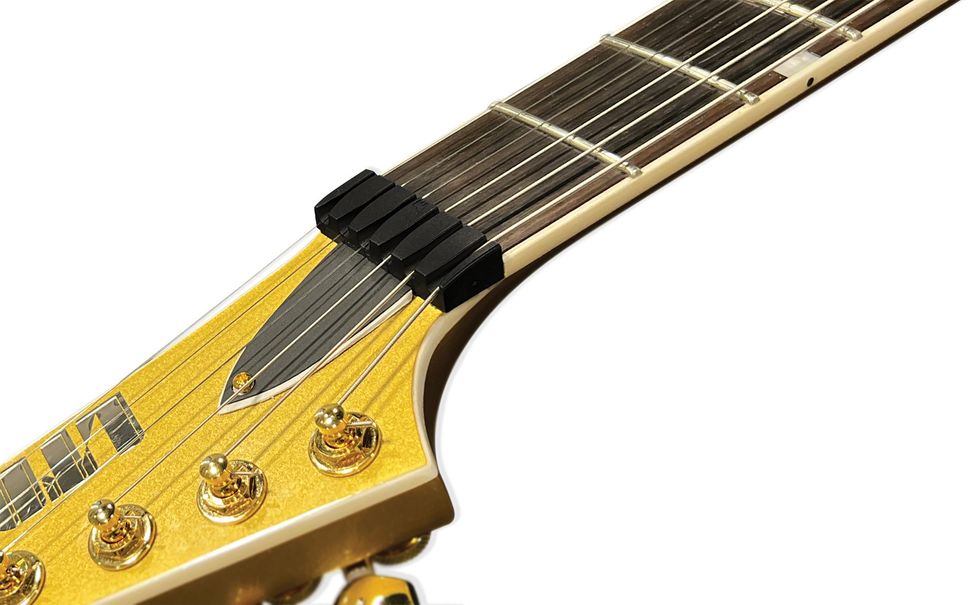
Un-Lock Nut
Unlock your nut and release the beast!
$35 street
Seymour Duncan
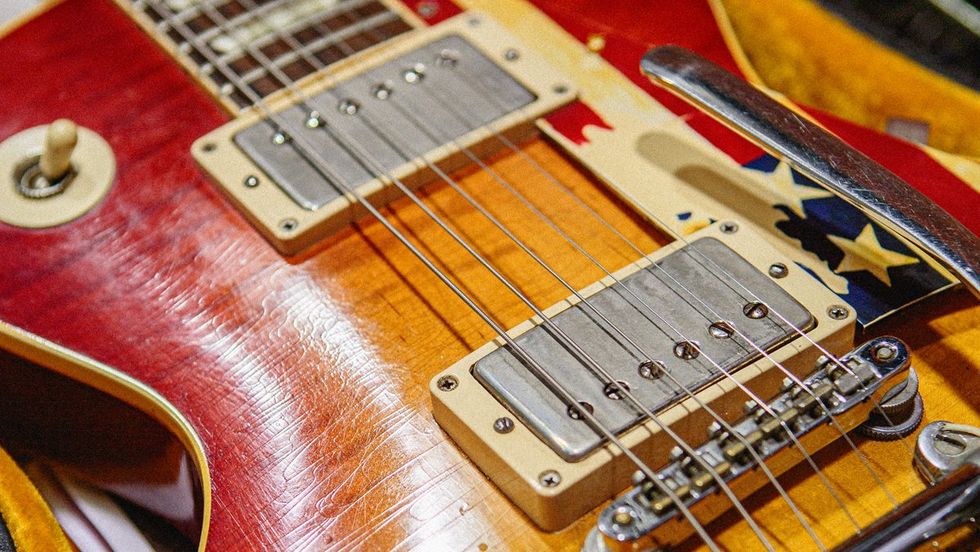
The Joe Bonamassa “Bolin Burst” Humbucker Set
Joe Bonamassa has long been a fan of Tommy Bolin, whose work influenced generations of guitarists. After a 10-year search, Joe acquired Tommy’s 1960 Gibson Les Paul and worked with the Seymour Duncan Custom Shop to recreate these P.A.F.s. The first 500 sets are signed by Joe and Seymour Duncan.
$375 street
StewMac
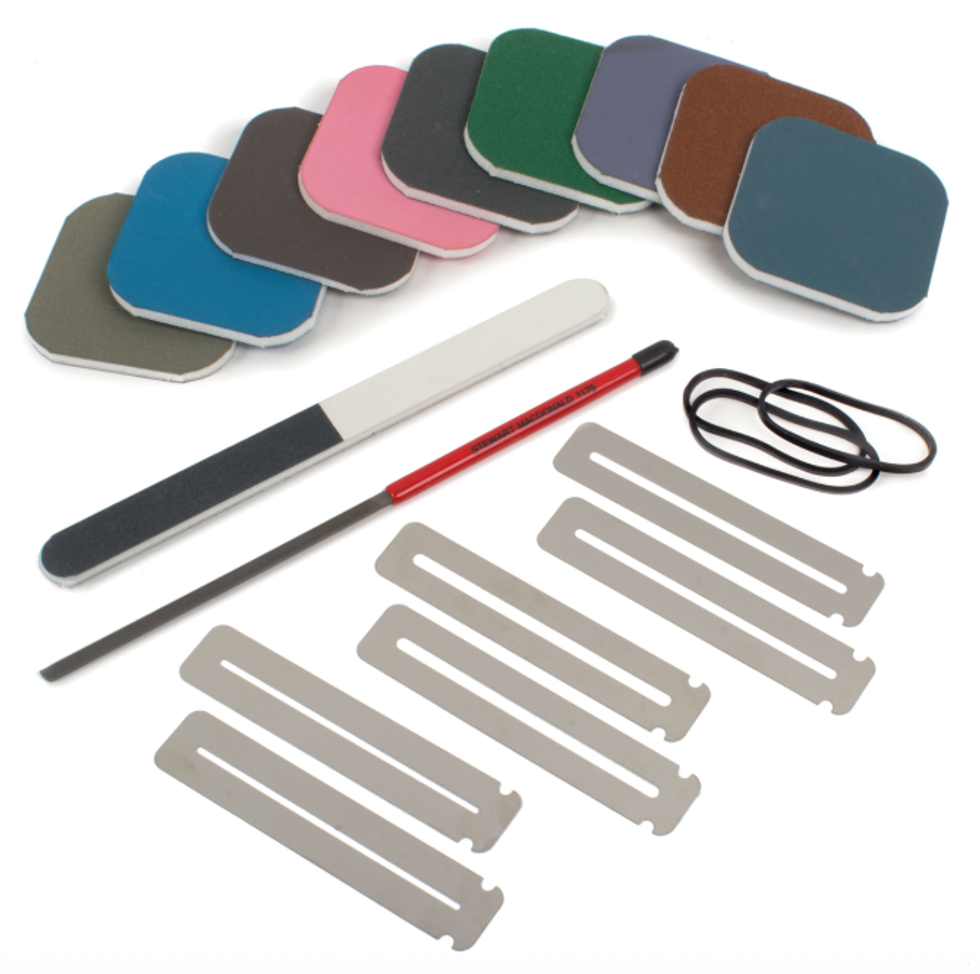
Rough Fret Smooth + Shine Set
Don’t let fret sprout stop you from playing your favorite guitar. This kit has everything you need to fix it yourself. When dry weather comes around, your fretboard can shrink and the fret ends poke out. Sharp fret ends can slow you down, feel uncomfortable, or cut your hand.
$69 street
StewMac
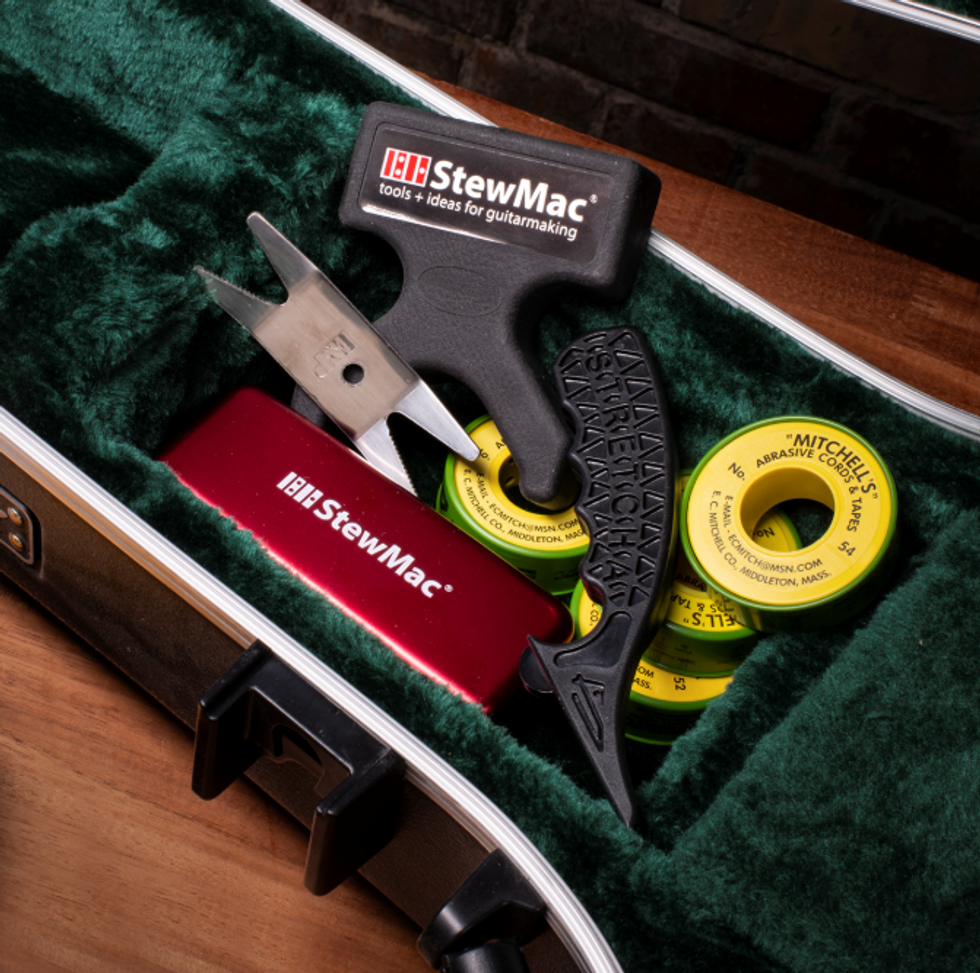
StewMac Guitar Tech Case Candy Set
When performing live, the small problems can turn a great show into a nightmare. A loose screw, slipping string, or guitar poorly leaned against an amp can create major stress. So, we created the Guitar Tech Case Candy Set—a compact collection of essential tools designed to keep your guitar stage-ready.
$140 street
stewmac.comFloyd Rose
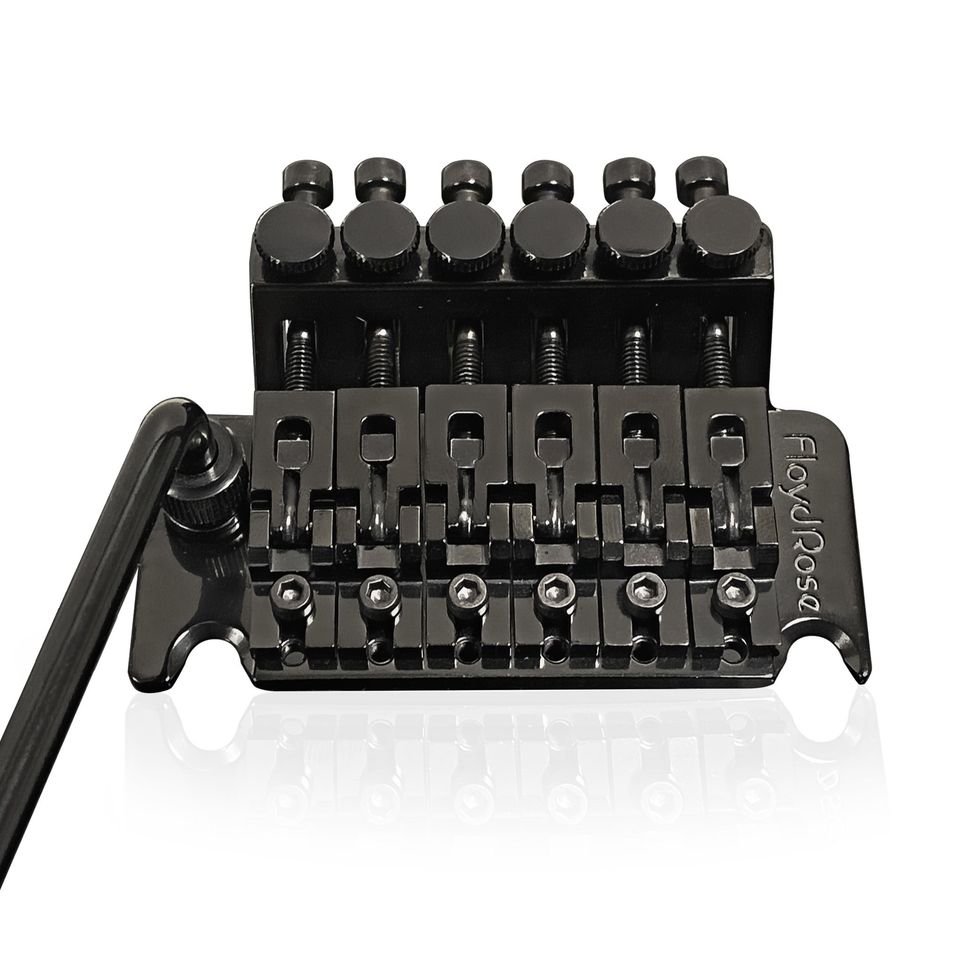
USA Original Radius Saddle Sets
Designed for matching specific fretboard curvatures, Floyd Rose Original saddle sets now offer several radius options without the need for individual saddle shims. Crafted in the U.S. from high-quality tool steel using precision CNC machining, the saddles are then heat-treated and plated to withstand the demands of the heaviest performers.
$110 street
Floyd Rose
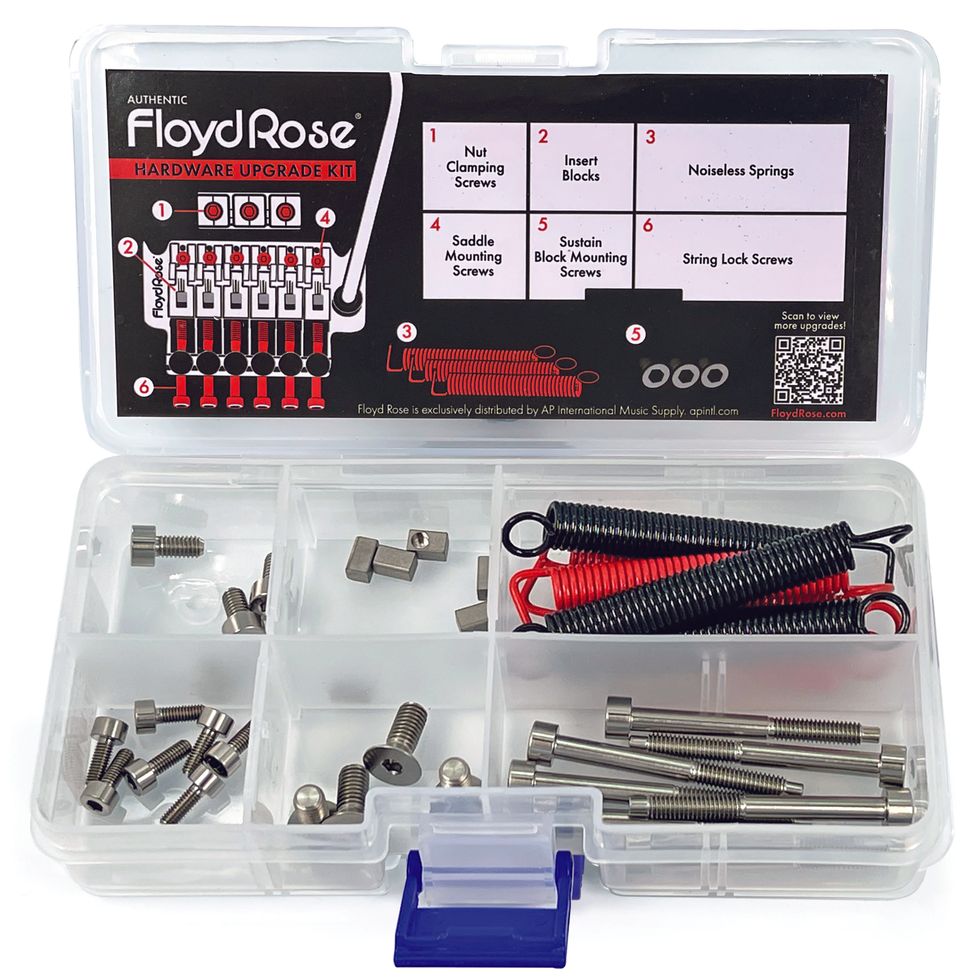
Hardware Upgrade Kits
Introducing authentic upgradable hardware kits for FR Tremolo Systems, available in eight stainless steel finishes as well as titanium. Each hardware upgrade kit comes with seven string-lock screws, seven saddle-mounting screws, four nut-clamping screws, four block mounting screws, and string lock insert blocks.
$63 street
Check Out This Pristine 1959 Les Paul Custom
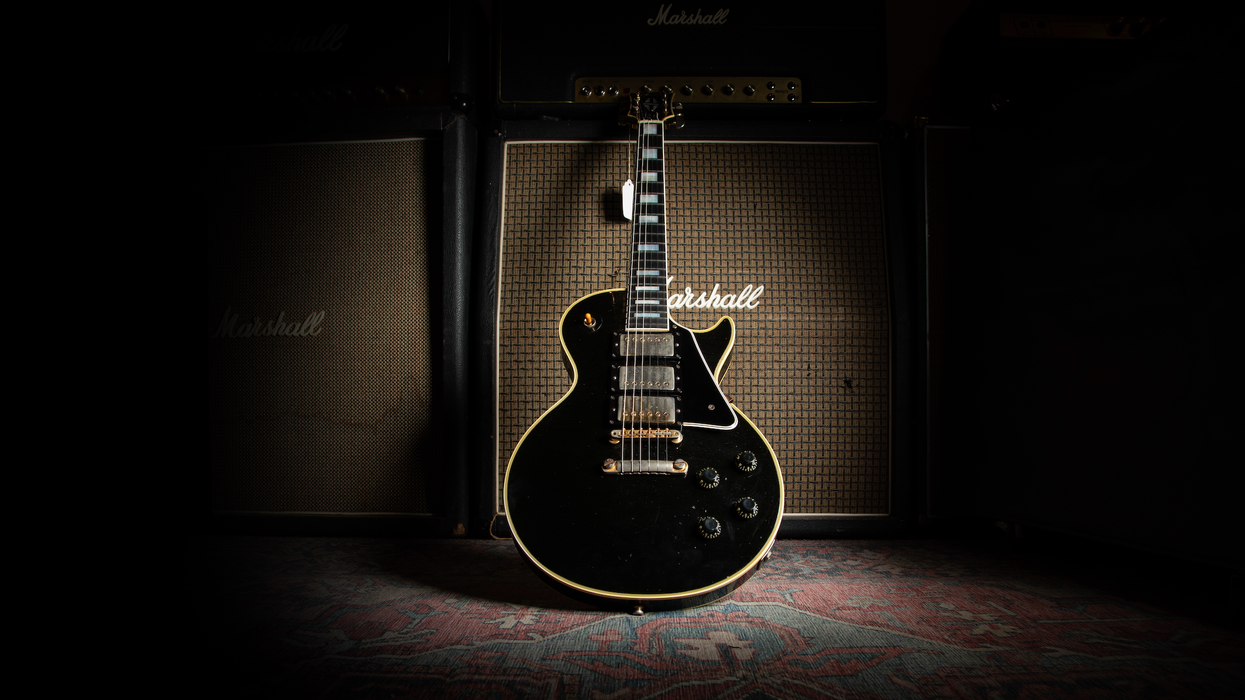
It’s been a minute since we’ve gotten to share something truly special with you all, and today’s subject is one of the finest: a 1959 Gibson Les Paul Custom.
Gibson introduced the first Les Paul Customs in late 1953, following a couple of prototypes built for Les Paul a year earlier. Les wanted what he called a “more elegant” version of the Les Paul Standard, something that looked sharp on the booming new medium of television. His request was specific: a black guitar with refined appointments and design tweaks to match his playing style.
The original Customs carried two pickups: an alnico “staple” single-coil in the neck and a P-90 in the bridge. They featured black finishes, white binding, gold hardware, and the split-diamond headstock inlay we now associate with the model. The headstock was slightly larger than the Standard’s, and the carve at the scarf joint was lengthened for easier play near the nut.
Perhaps the most distinctive feature was the fretwork. Les requested low, wide frets, which led to the nickname the “Fretless Wonder.” While iconic, these frets can feel unusual to modern players. Still, Les’ highly developed technique probably made frets almost unnecessary for him. Another major innovation appeared on the Custom: the debut of the ABR-1 Tune-o-matic bridge, finally giving players accurate intonation adjustment.
Here’s an interesting twist in the Custom’s story. Les’ original vision called for the Standard to be built from solid mahogany with a gold-painted top, and the Custom to use a maple cap on mahogany, finished in black or white. Gibson flipped those specs. The production Standard ended up with a maple cap, while the Custom was built entirely of mahogany.
The all-mahogany build gave the Custom a darker sound, so Gibson used an ebony fretboard to restore some brightness. Meanwhile, the maple-topped Standard was paired with a warmer Brazilian rosewood ’board. Ironically, it wasn’t until 1968 that the Custom attained the maple top Les had wanted all along.
“Instruments like this inspire players across generations.”
The next major leap came in 1957, when Gibson introduced Seth Lover’s groundbreaking humbucking pickups. By mid-year, the Les Paul Custom carried not two but three humbuckers. This gave players a wide tonal palette spanning jazz, pop, country, blues, and eventually rock. In time, artists like Keith Richards and Jimmy Page made unforgettable recordings on Customs, further cementing the model’s place in music history.
That brings us to the stunning 1959 Les Paul Custom currently here at Carter Vintage. I had the chance to spend a morning with it, and it’s easily one of the best-playing guitars in the shop.
Remember my earlier complaint about the “Fretless Wonder” frets? This one has been given a perfect refret by our repair shop. The result is transformative. Suddenly the Custom plays effortlessly, like a hot knife through butter. The setup is dialed in to perfection, and honestly, I walked away a little jealous. It convinced me that a couple of my own guitars need some attention from our techs.
Plugged into a Deluxe Reverb, the guitar absolutely sang. The original PAF pickups deliver remarkable clarity and punch. There’s excellent balance between the bridge and neck, and the middle position, often prone to phase issues, sounds smooth and full-on. Perfect for bluesy bends or country runs.
The neck deserves its own praise. It’s the quintessential ’59 carve: not too big, not too thin, with shoulders that make it feel more manageable than its actual measurements (.89" at the nut, 1.01" at the 12th fret) suggest. Simply put, it’s a neck that disappears in your hands, feeling comfortable, fast, and inspiring.
This particular Custom has been thoughtfully maintained. Aside from the refret and a new nut, the electronics and pickups remain untouched, and the finish is all original and in excellent condition. At about 9.5 pounds, it’s substantial, but its balance makes it feel lighter than the number on the scale suggests.
The Les Paul Custom has always been a guitar steeped in history. Born from Les Paul’s vision, refined by Gibson’s innovations, it was carried into legend by the players who made it sing. This 1959 example embodies all of that and more. With its perfect refret, killer PAFs, and ideal ’59 neck, it’s a joy to play and living proof of why this model continues to hold such a revered place in guitar history.
For me, it wasn’t just another morning with a guitar—it was a reminder of why instruments like this inspire players across generations.
Written with help from Andrew White.
Striking a New Chord

I’ve been writing about music and music gear, in one form or another, for many decades now. I’ve been playing music—writing, recording, performing, for even longer. And I’ve been reading music magazines—specifically guitar magazines—longest of all.
As a child, music magazines were treasure troves of insider knowledge and practical—or, depending on the artist being interviewed, thoroughly dubious—wisdom. They were to be studied, pored over, dog-eared, and piled in messy, corner-of-the-room stacks that eventually got jammed into messier, stuffed-to-the-point-of-exploding cabinets. With guitar magazines, this fascination, and pack-rat behavior, was amplified in every way. It felt like the secrets to an entire universe were unlocked every month. And not just the basics like how to play, what to buy, and what was new. You learned how to write and arrange music, how to change strings, how to repair necks, how to wire pickups, how to modify amps, how to design a signal path, how to establish your own unique sound. How to create.
This creative spirit is what I feel has always set guitar magazines apart, from back in the days when the industry was crammed full of titles and print was the main engine, to now, when it’s even more crucial to give readers something tangible—to entertain, but also to teach. To explore and inspire. To discuss, commiserate (because let’s face it, this world can often be frustrating and challenging), and build community around our shared obsession.
This mindset led me into journalism and has kept me here all these years. And so it’s with tremendous excitement and pride that I join Premier Guitar as your new Editorial Director. I’ve been reading the title since its inception, and over the years have contributed stories on artists I greatly admire—I’ll point to interviews with Thurston Moore and Jim Campilongo as two recent examples. I’ve known our recently retired Editorial Director Ted Drozdowski since I was a managing editor in my first magazine job out of college (trust me—that’s a long time), and I thank him for this incredible opportunity.
I’ve always loved Premier Guitar for delivering quality content from some of the most knowledgeable people in the industry. And it’s not just about putting the stars of the day in every issue—we tell stories from every corner of our musical universe. This issue exemplifies that approach. We celebrate the unsung heroes who keep our industry humming, with a feature on StewMac and Allparts—companies that have revolutionized the DIY guitar universe, and spotlight the often-overlooked guitar techs whose expertise keeps our biggest names sounding their best, night after night.
We also showcase the standard bearers and icons. We sit down with legends like Vernon Reid, a fellow New Yorker whom I had the privilege of interviewing about his new solo album, Hoodoo Telemetry, which finds him gathering sounds and influences from across space and time. We go deep with ascending talents like Daniel Donato, whom I recently watched deliver some incendiary cosmic country with his band, the aptly named Cosmic Country, ripping truly mind-boggling licks on his DGN Custom Epoch semi-hollow under a perfect late-summer evening sky. We dive into experimental territories with Los Angeles metal band Agriculture and their challenging new record The Spiritual Sound, and visit with Winnipeg’s Living Hour to explore their dreamy, noisy soundscapes.
And on our cover, we have Daron Malakian—a figure who straddles both worlds as one of the oddest and most unlikely mainstream rock stars—examining his creative process with both System of a Down and his own project, Scars on Broadway. His approach to songwriting and guitar playing challenges conventional thinking in the best possible way.
But none of these artists outshine our columnists, who month after month provide some of the most insightful commentary in the guitar universe. Their expertise and passion illuminate everything from technique to tone, from vintage gear to cutting-edge technology. They cover everything from oddities to esoterica to recording to performing, drawing from lifetimes of experience.
And then there’s the gear itself—the star of our show. Whether you’re hunting for your next dream guitar, investigating the latest pedal innovations, digging into amplifier design, exploring software and recording technology, or tracking down that one missing link that’ll finally complete your rig, we’re here to guide you through it all.
There’s also exciting news on the horizon. We’re working on a fresh new look and implementing several behind-the-scenes improvements that will enhance your Premier Guitar experience. Stay tuned—good things are coming.
My goal is simple: to continue Premier Guitar’s tradition of being your most trusted guide through this ever-changing landscape. Whether you’re a weekend warrior, a touring professional, or somewhere in between, we’re here to feed your passion, fuel your creativity—and help you seriously geek out on guitars and gear.
Now let’s make some music together.
Martin Guitar Unveils OM Mikael Åkerfeldt Signature Model
Today at Guitar Summit in Mannheim, Germany, C. F. Martin & Co.® unveiled the OM Mikael Åkerfeldt, a limited-edition acoustic created with the Opeth frontman. Only 74 guitars will be made worldwide, honoring the Swedish musician’s 1974 birth year.
The OM Mikael Åkerfeldt blends Martin’s renowned craftsmanship with bold new features. It pairs a torrefied spruce top with a dramatic three-piece back of Guatemalan rosewood and an East Indian rosewood wedge, accented by European flamed maple binding. For the first time in a traditional body, Martin has introduced its Low Profile Velocity neck—designed for our SC models, and ideal for players used to the speed and comfort of an electric.

Personal details include an ebony fingerboard with black mother-of-pearl Roman numerals and black Liquidmetal® bridge pins for added sustain and clarity. Inside, VTS-treated spruce and Golden Era scalloped X-bracing—as featured on the Modern Deluxe Series—deliver vintage warmth and dynamic response.
“Is this the best guitar I’ve ever played? Including the ones in your museum? I believe so,” Mikael said. “It just sings—the resonance, the clarity, the low end. Everything about it feels magnificent.”
Each guitar includes a laser-etched stainless-steel label and custom Harptone case.
ABOUT MIKAEL ÅKERFELDT
Mikael Åkerfeldt is the frontman, guitarist, and primary songwriter of the pioneering progressive metal band Opeth. Since joining in the 1990s, he has led the group from its death metal roots into genre-defying territory, blending guttural growls with clean baritone vocals and weaving progressive rock, folk, and classical influences into its sound. Under his leadership, Opeth has earned two Swedish Grammis awards and established itself as one of Scandinavia’s most influential metal bands.
Mikael's artistry extends well beyond Opeth. He co-founded Storm Corrosion with Steven Wilson, contributed vocals to Bloodbath, and composed the score for the Netflix series Clark. Ranked among the greatest modern metal guitarists, he is also a devoted vinyl collector and music historian with a deep reverence for tradition and craft. His connection to Martin guitars goes back to the early ’90s, when he sold them at a small shop in Stockholm. Decades later, that relationship comes full circle with his own signature Martin—a collaboration that unites elegance, darkness, and uncompromising creativity.
NS Design Unveils New Carbon Fiber Fin Guitar and Bass
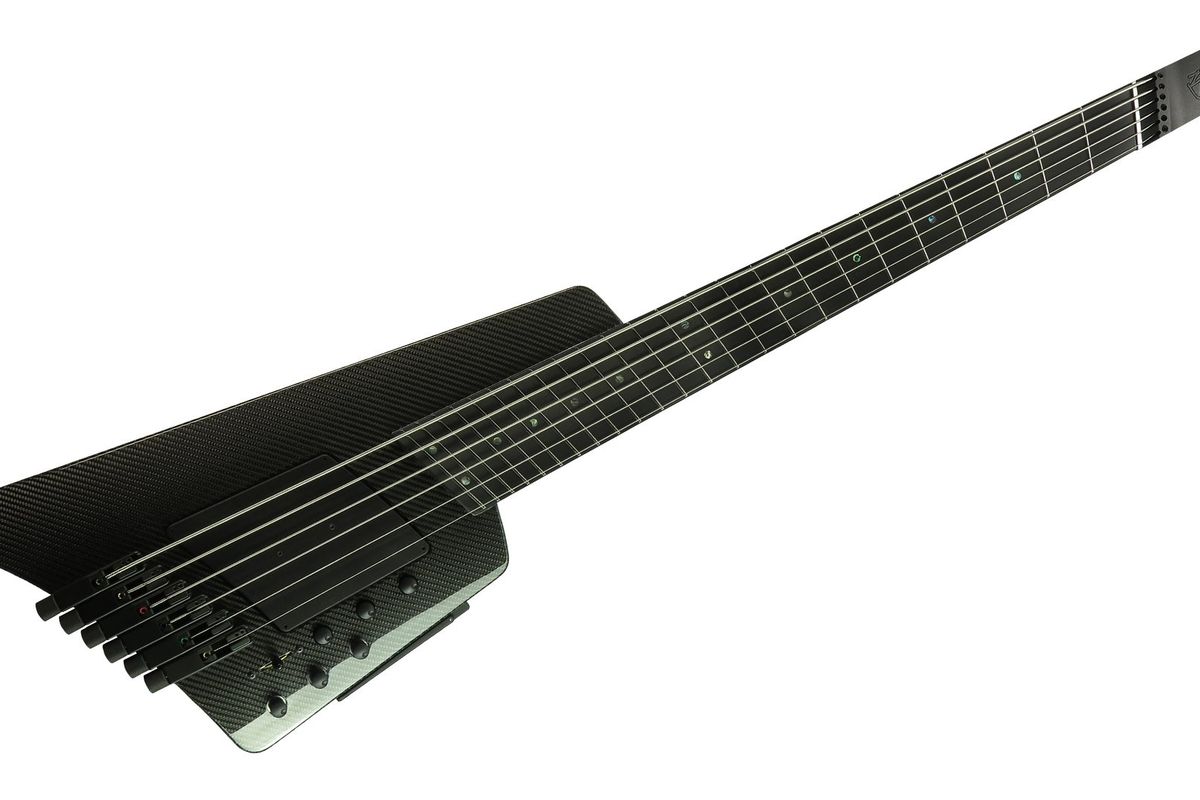
Ned Steinberger, inventor of the headless bass, has unveiled his new NS Design Fin guitar and bass at the Mannheim Guitar Summit in Germany. These multiscale instruments are available in 6-string configurations and combine cutting-edge carbon fiber construction with innovative electronics to deliver unparalleled sonic performance for the modern musician.
Key features of the NS Fin Guitar and Bass include:
- All-carbon fiber construction for extended sustain, brilliant harmonics, and bold low-end response.
- Lightweight ergonomic design - Guitar weighs just 5½ lbs., bass only 8 lbs., with perfect balance.
- Modular pickup configuration allows any combination of humbucking and single-coil pickups.
- Revolutionary Activator™ circuit by Mi-Si™ with supercapacitor power and up to 12dB boost.
- Fulcrum™ tuning system features a patented self-clamping mechanism for quick string changes.
- The scale length ranges for the guitar and bass - Guitar: low E string 26 inches, high E string 25 inches. Bass: low E string 35.3 inches, high C string 32.7 inches.
- Multiscale fretboard provides optimized string tension and intonation for enhanced playability.
NS Design’s Fin Guitar is priced at $8,500 USD, and the Fin Bass is priced at $9,500 USD. They are available in a limited-edition run of 12 each, made in USA from 100% carbon fiber. For more information visit thinkns.com.
PRS SE NF 53 Review
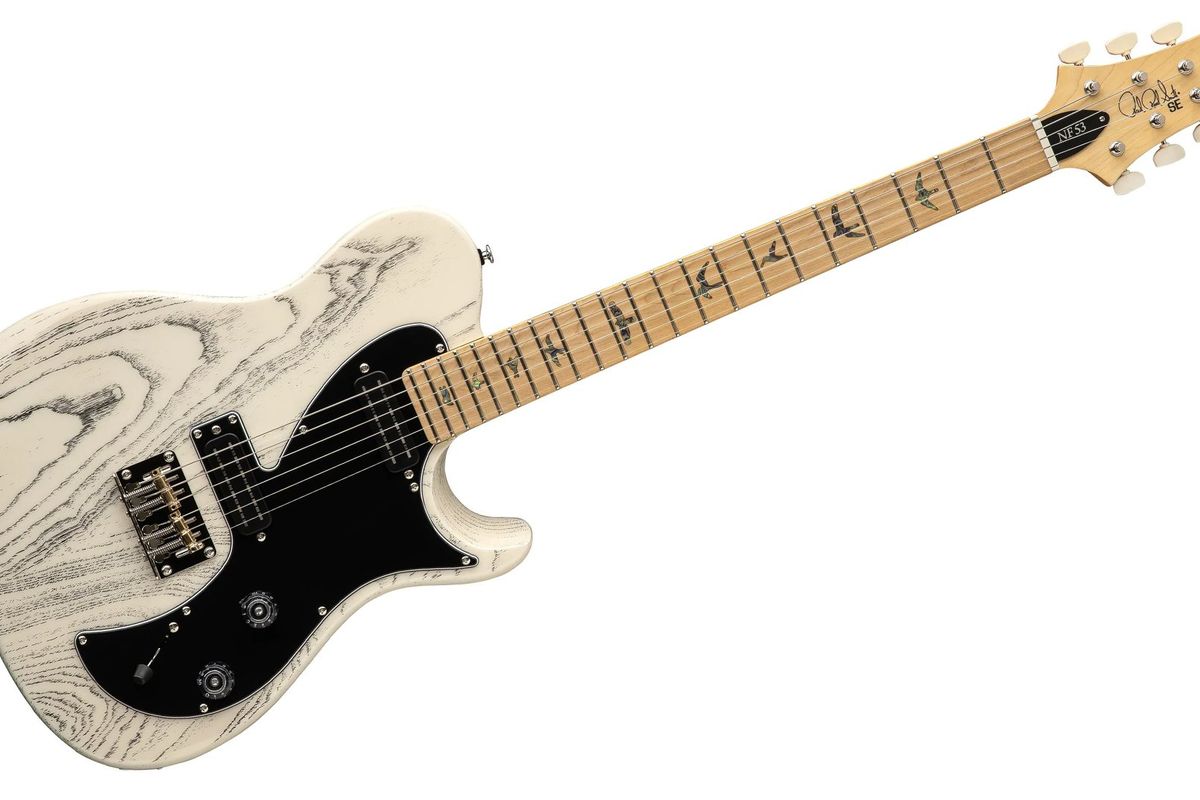
Like the Silver Sky, the NF 53 revealed Paul Reed Smith’s deep reverence for classic Fullerton designs and curiosity about how to expand on those templates. 2023’s NF 53 release left us impressed, and it was only a matter of time until an offshore-built SE model followed. That time has come: The SE NF 53 is here, dressed in the same lines and livery as the USA-built model, but at a more affordable price point thanks to PRS-licensed and supervised manufacturing by the Cor-Tek Musical Instrument Co. in Indonesia.
Like the NF 53, the SE model is more a riff on the Telecaster theme than a copy. Unburdened by tradition, PRS carved away at every line of the single-cutaway form, and the electronics are very much about enhancing versatility, rather than reducing componentry to the absolute basics. Even so, the SE NF 53 still drips with Tele-ness.
Single-Cut Minded
T-style traditionalists will find much that feels familiar, like the 25.5" scale length and bolt-on maple neck. From there, though, the SE NF 53 deviates from vintage T-style spec pretty quickly. There are 22 medium-jumbo frets, and the neck is constructed with a scarf joint that increases strength at the headstock break. The maple fretboard is sliced away from the neck and reglued after installation of the truss rod. Its width at the nut falls between Gibson and Fender camps at 1 41/64". The 10" radius also splits the difference between vintage Gibson and Fender specs, and it all feels great in hand courtesy of a rounded-C profile that measures about .87" deep at the first fret. The guitar’s overall weight is around 8.1 lbs.
In Telecaster style, the SE NF 53’s body is made from swamp ash—in this case, using 3-piece construction. It features belly and forearm contours, and a contoured cutaway for easier upper-fret access. PRS maximized the drama of the ash’s distinctive grain with a white doghair finish on our review sample, and black grain filler makes the wide, rippling lines pop and weave beneath the white. They reverse the effect entirely on the black doghair version, and hide the grain entirely on the pearl white finish.
In the hardware department, the SE NF 53’s bridge nods to a vintage Telecaster’s brass barrel saddles, but it uses a steel-base design with string-anchor notches rather than through-body stringing. It also deviates from T-style tradition by assigning three strings to a saddle with two adjustment bolts, rather than three saddles with two strings each.
Like the USA model before it, the SE NF 53 is fitted with a pair of PRS’s Narrowfield DD pickups, although these are the “S” variant, which are designed to enhance low-end tones while retaining snarl and twang. The “DD” stands for deep dish, meaning these single-coil-sized humbuckers are made with deep bobbins to enable extra coil windings, using a mix of magnet pole pieces with steel poles in between. They are wired through master volume and tone controls and a three-way selector switch on a plate that nods toward the late ’60s Fender Telecaster Thinline.
Taken together, the SE NF 53 is a cohesive design, made stronger by its robust build quality. There’s no real lack of refinement in evidence when compared to the USA model. Some of the woods and components are a different grade, but the overall result is a guitar that lends a sense of confidence.
Field Day
Plugged into a Fender Bassman head and 2x12 cab, a Vox AC15 1x12 combo, and a Fractal FM9 into headphones, the guitar reveals a genuine alternative to the T-style formula suggested by its components. Its character is distinctly its own—and with noticeably less hum.
The Narrowfield DD “S” pickups play a big part in the guitar’s success. The easiest reference point I can think of might be a blend of Telecaster and P-90 tonalities, but with plenty of their own thing going on. With a clean amp or setting there’s a meaty growl on top of the twang. Yet the guitar isn’t short on bright, sparkly chime, and sounds alive in those frequencies without being strident or spikey. This sonic foundation puts edge-of-breakup tones right in the SE NF 53’s wheelhouse, where the chewy bite segues into a little bit of breakup when you hit it hard. And it’s just as comfortable with high-gain tones, where the same sonic characteristics that contribute sweetness in cleaner settings enable clarity and cutting power while avoiding harshness in the highs. In fact, the guitar is at home in so many settings, sharing a Telecaster’s versatility and its effortless ability to handle almost anything with style.
The Verdict
The NF 53 platform is a very likeable tribute to the seminal T-style without trying to replicate it and, as a result, it’s versatile and inspiring guitar in its own right and in its way. And in the SE version of this design it delivers at a price that belies its vocabulary and its confidence.
Pedalmania! Keeley, Mr. Black, Hotone, and NUX Demos
As the leaves change and the holiday season approaches, PG contributor Tom Butwin highlights standout pedals from the bevy of tone machines that graced shelves this year. In his first installment of Pedalmania, hear demos of the flexible Keeley Manis Overdrive, Mr. Black's DoubleTracker Stereo, the spacey new Hotone Verbera convolution reverb, and the featured-packed NUX Amp Academy Stomp.
Remembering Tony Rice: 8 Iconic Licks from the Master Guitarist

In December of last year, Tony Rice passed away. He was/is my all-time favorite guitarist. Like many of his fans, my love of his playing has likely transcended obsession. In fact, at the time of writing this, I have transcribed over 100 Tony Rice solos. That puts me in a unique position to share with you not only my favorite Tony Rice licks but what I think might be Rice's favorite licks, if the frequency with which he played them is any indication.
These examples can be found in almost every Tony Rice break. They are integral to his sound and they can become part of your sound too. This comes with one small warning though: These licks are not meant to be parroted off this page. A big hallmark of this sound is to use these phrases but to vary them, and create your own versions of them. Let's remember Rice by innovating on his past achievements the same way he innovated on the achievements of the players that came before him.
How to End a Bluegrass Song
One of the most famous and enduring Tony Rice licks is this signature tag. A tag is a common way to end a bluegrass fiddle tune or vocal song, the most generic tag being the ubiquitous "shave and a haircut." In Ex.1, you can see what's called a "double" tag. The first tag ends on beat 3 of measure two, before the open 3rd string on beat 3. The remainder of the lick forms the second tag, which eventually morphs into a variation of the Lester Flatt "G run."
Rice's note choice is predominantly major pentatonic but includes an occasional b3 that always resolve down to the 2 or up to the 3. As I say to my students, "Blue notes need buddies." Playing these pairs of notes with articulations like slides and pull-offs that cross bar lines is an important part of Rice's style.
Tony Rice Ex. 1
Use Your Chords
If you're familiar with triads on the D, G, and B strings, you can turn those into bluegrass licks as well. Rice has used the triads in Ex. 2 in a handful of different and interesting ways. He's used the last two chord shapes to form the main riff for "Me and My Guitar," and employed those same shapes to punctuate the end of his "Cold on the Shoulder" kick-off. Sometimes you can see him expand this idea by using even more chord shapes to descend the neck. He would use something like Ex. 2 in a G major context but would be heavily implying G Mixolydian mode by using the F major and D minor triads.
Tony Rice Ex. 2
That One Lick
I've seen this passage referred to multiple times as "that one Tony Rice lick." He uses variations of this passage to finish breaks in "Your Love Is Like a Flower," "Ain't Nobody Gonna Miss Me When I'm Gone," and "Gold Rush." It serves the function of a statement piece to assert his personal voice on the instrument before handing off the spotlight to the next instrumental break or verse of a song with vocals.
As you play Ex. 3 be mindful of how you use your pinky. Every note on the 10th fret is played with the pinky, including a brief pinky barre on the 10th fret of the 3rd and 4th strings.
Tony Rice Ex. 3
Pull-Off Central
This lick has been featured in recordings, but I associate it much more with Rice's live sound. Whenever Rice needs a second to think about what to play next, Ex. 4 seems to come to his fingers first. The note choice here lands firmly in the minor pentatonic camp but he manages to create a little bit of an outside sound with the third iteration of the pattern that brings in the b5 at the 6th fret of the G string.
Tony Rice Ex. 4
Escape Notes
Have you ever been stuck up the neck improvising with no idea how to get back down to something more familiar? Me too! So, let me introduce you to escape notes. Sometimes you can find an open string that will continue your line in a linear fashion while freeing up your hand to shift down the neck. Take a look at the F, E, and D eighth-notes in the first measure of Ex. 5. Rather than playing those three notes in position, Rice is using the open 1st string so he has time to shift his hand while continuing his eighth-note line.
There are examples of Rice using variations of licks like this in "Blue Railroad Train," "A Hundred Years from Now," and "Likes of Me." You can use this in a D major context or in a G major context over a D chord.
Tony Rice Ex. 5
Acoustic Bends
It can be done, and in a situation like this we're not necessarily shooting for something perfectly in tune. In Ex. 6 you can see that pulling down on the 4th string at the 3rd fret will bring the note closer to F#, the 3 of the chord, but in practice Rice usually doesn't get all the way there.
Tony Rice Ex. 6
Phrasing
If you asked a random flatpicker at a bluegrass festival to play a Tony Rice lick, they would probably play something like Ex. 7. These types of phrases have endless variations and demonstrate Rice's long-standing influence on bluegrass music. These licks are built from a G minor pentatonic (G–Bb–C–D–F) bone structure but always feature a pull-off from the 2nd fret to the 1st fret on the B string and a slide from 3rd to 4th fret on the G string. This pull-off and slide are great reminders that blue notes need buddies.
Tony Rice Ex. 7
True Minor
Bluegrass isn't all major tunes though. There are standards in minor keys. We're talking about tunes that are actually minor—not just playing minor pentatonic licks over major chords. With that in mind, it would be wrong of me to not mention Ex. 8, one of Rice's favorite improvisational ideas to employ over minor tunes. This kind of lick is all over Rice's original compositions in minor keys and the recordings he made with David Grisman. The idea is framed in a slightly ambiguous way, so you can find Rice using it in A minor and D minor.
Tony Rice Ex. 8
It's an impossible task to completely distill Tony Rice's playing into a single lesson. I would point you to nearly any album in his discography to get the essence of modern bluegrass guitar right from the source. His touch, feel, tone, and vibe forever changed acoustic music and we all will be eternally grateful.
Essential Tony Rice Videos
Tony Rice liked to perform "Me and My Guitar" with an extended jam in the middle. Many licks from this lesson appear in his guitar break at 6:00.
Tony Rice's "Church Street Blues"
There's very little footage of Tony Rice performing his iconic interpretation of Norman Blake's "Church Street Blues." This arrangement may be one of the most difficult to replicate from Rice's catalogue.
Tony Rice's "Old Home Place"
Tony Rice performs on the definitive recordings of multiple bluegrass standards but "Old Home Place" may be the most important. JD Crowe & The New South's self-titled release is considered by many to be a near perfect bluegrass record.
Tony Rice "Shenandoah"
Most folks talk about Tony Rice's hot-style playing but his melodic chord melody approach to guitar is equally impressive. I doubt we'll ever see an accurate transcription or performance of this era of Tony Rice.
Aluminati Guitar Company Introduces the Floodcaster
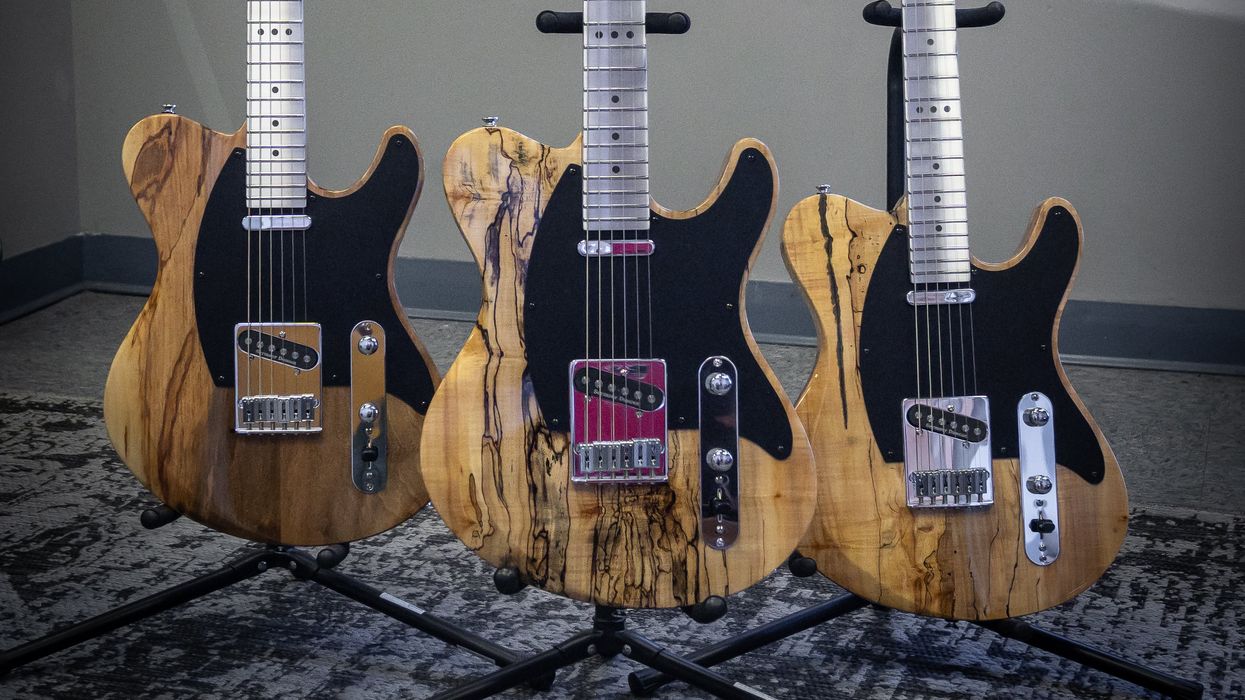
Aluminati Guitar Company, a pioneer in sustainable guitar manufacturing, is proud to unveil the Floodcaster— a guitar with a story to tell. Built from wood reclaimed from the aftermath of Hurricane Helene’s catastrophic flooding in Asheville, these instruments blend history, innovation, and sustainability in a way never before seen in the industry.
When floodwaters surged through Asheville, homes, businesses, and studios were left devastated. Seeking to give new purpose to damaged materials, Aluminati salvaged enough reclaimed wood for a charitable run of guitars. Paired with Aluminati’s precision-engineered aluminum necks, the Floodcaster is a guitar that not only delivers exceptional performance but also tells the story of Asheville’s resilient community.
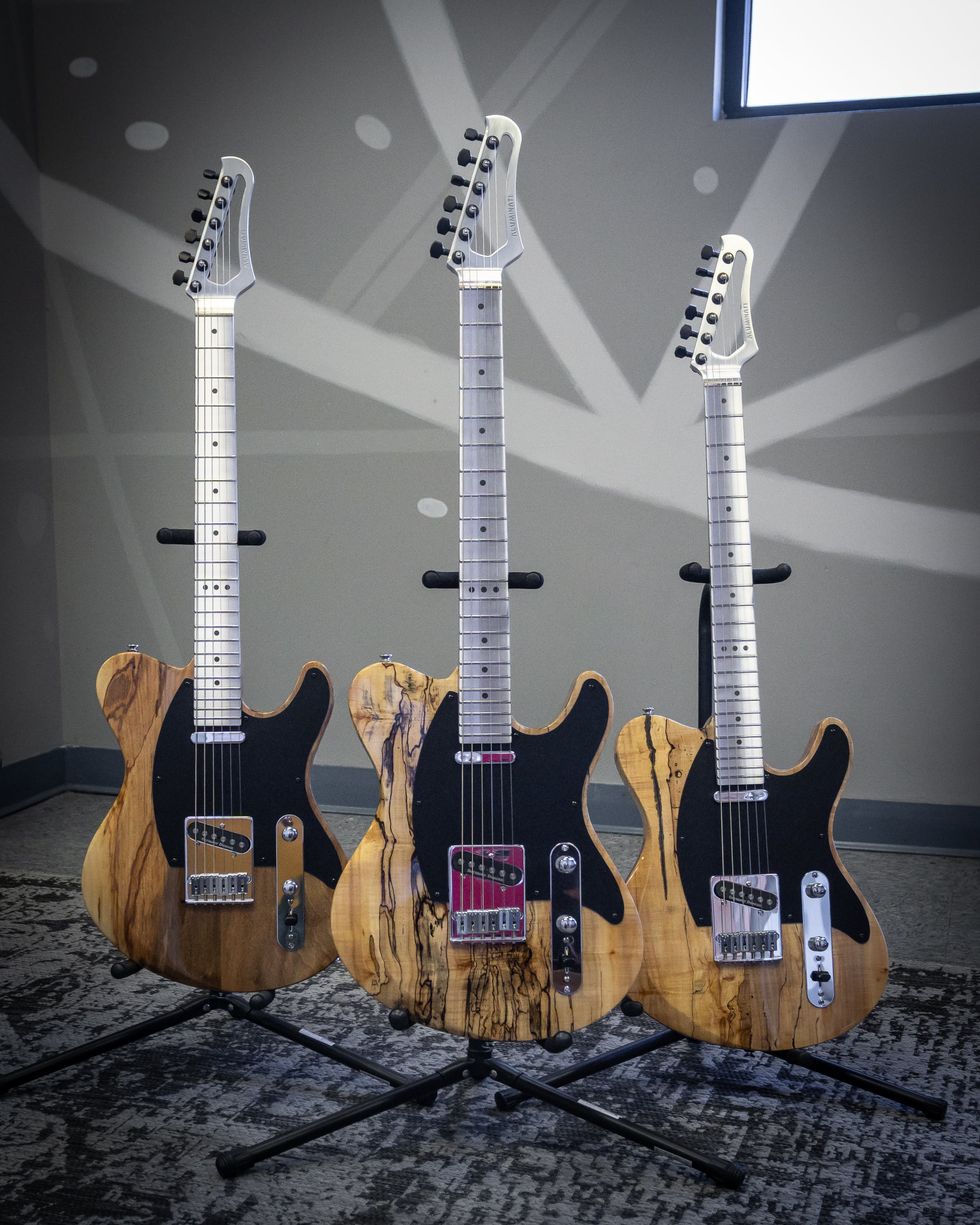
“Every piece of wood used in the Floodcaster Model has a story, and we’re turning that story into an instrument that players will cherish,” says Aluminati CEO, James Little.
Featuring unmatched sustain, clarity, and durability, the Floodcaster is built for modern players who value both performance and craftsmanship. With reclaimed materials giving each guitar a distinctive character, no two Floodcasters are exactly alike.
Giving Back to WNC
A portion of the proceeds from each Floodcaster sold will go directly to relief efforts in Western North Carolina, supporting communities still recovering from the devastation of Hurricane Helene. By putting these materials back to work, Aluminati is not only creating exceptional instruments but also helping rebuild what was lost.
After the initial release, Aluminati plans to partner with high-profile guitarists who will play and sign a select number of Floodcasters. These one-of-a-kind instruments will be sold at auction, with a portion of proceeds going directly to WNC relief efforts.
The first run of Aluminati Floodcasters will be available for purchase at $6,999 on Aluminati’s website, September 27th, 2025.
Floodcaster Specs:
- Aluminati HollowCore™ Aluminum Neck
- Aluminum Fretboard
- Sperzel Locking Tuners
- Jescar Jumbo Stainless Steel Frets
- Bolt-on Brass Nut
- Seymour Duncan ¼ Pounder Tele Pickups
- 3-way Toggle with a reverse control plate for volume swells.
- Gotoh Modern Tele Bridge
- Reclaimed Spalted Maple Body
- 25.5” Scale with 22 Frets
- 12” Radius
- D Shape neck
- Hand Wired and Finished
- 250k Bourne Pots

